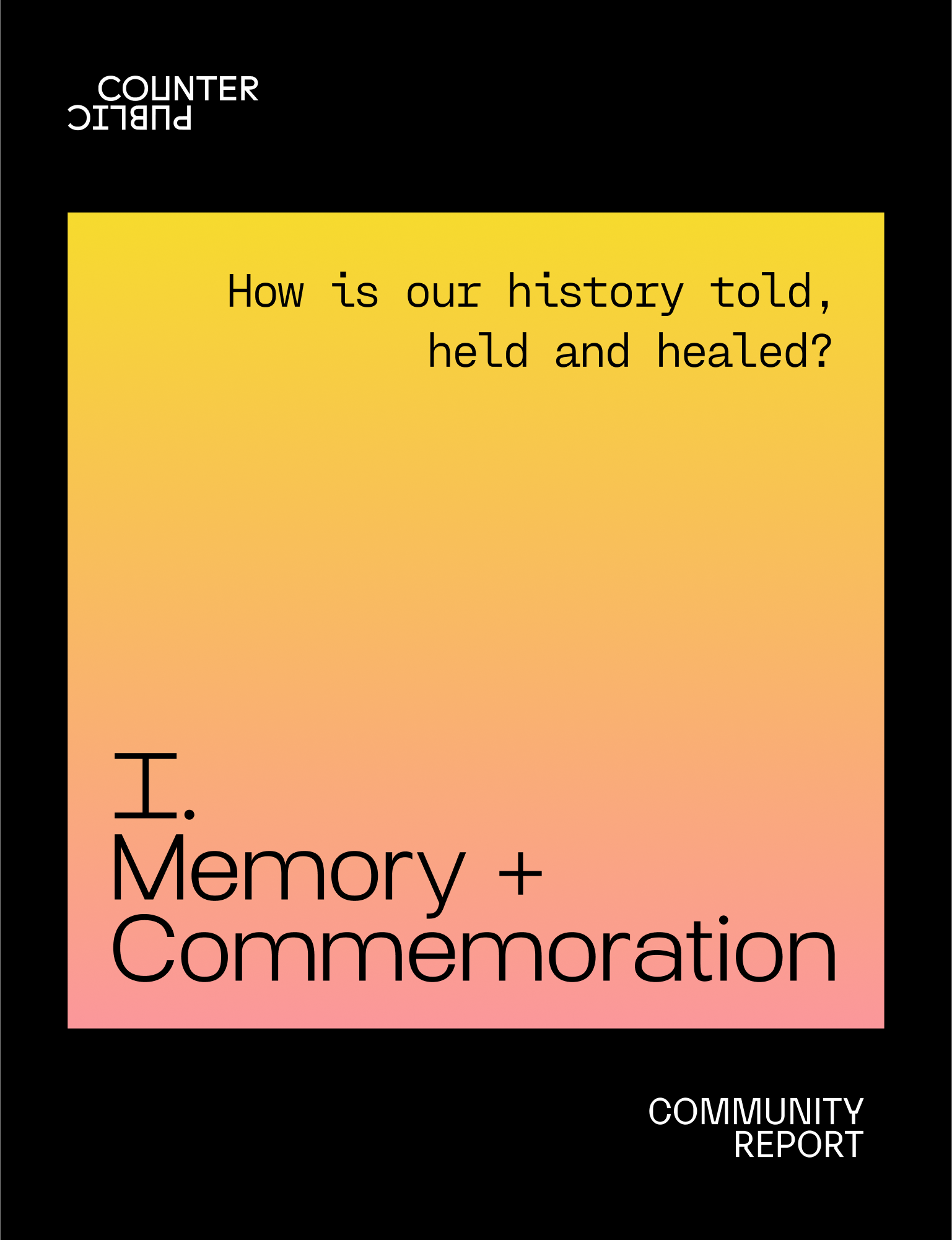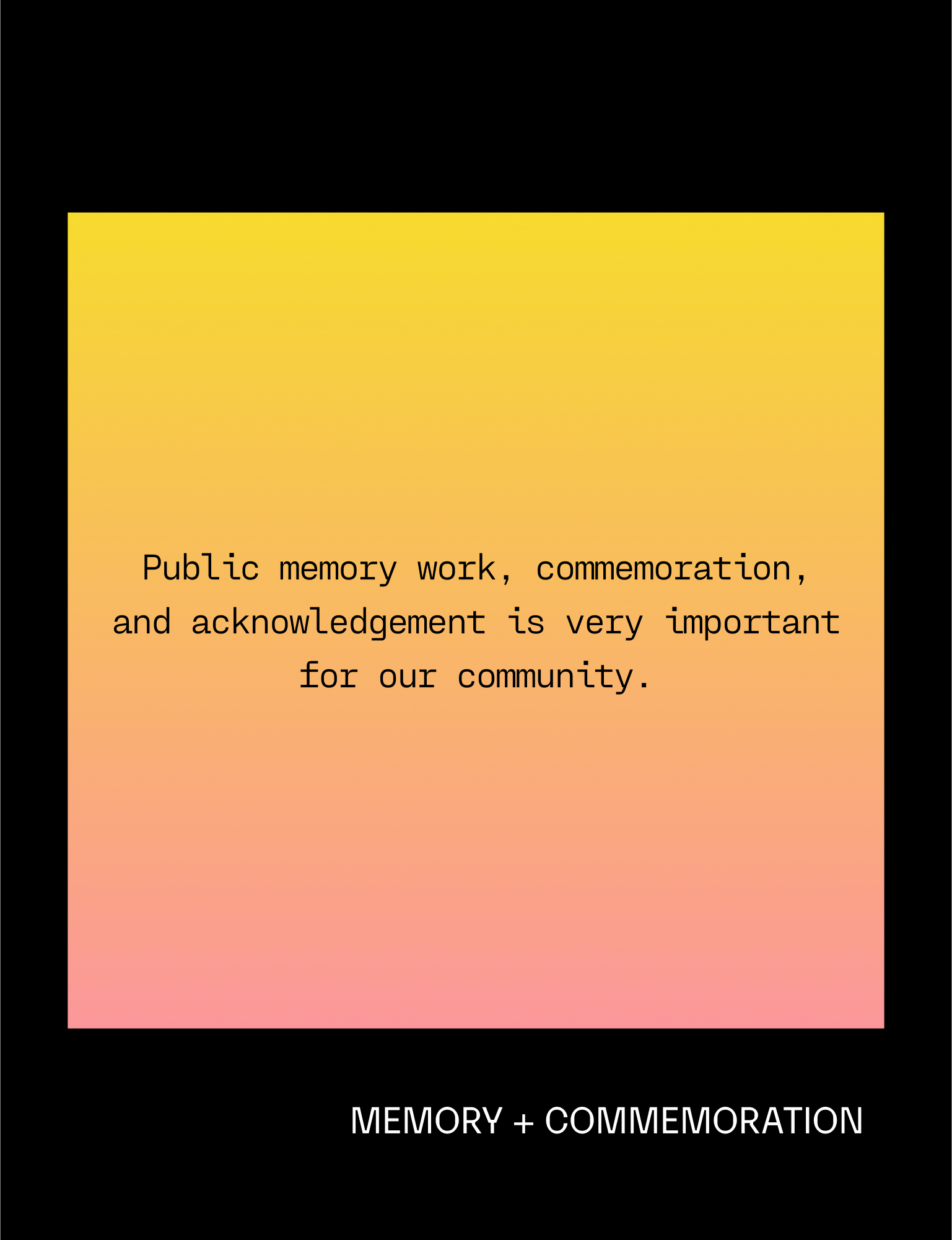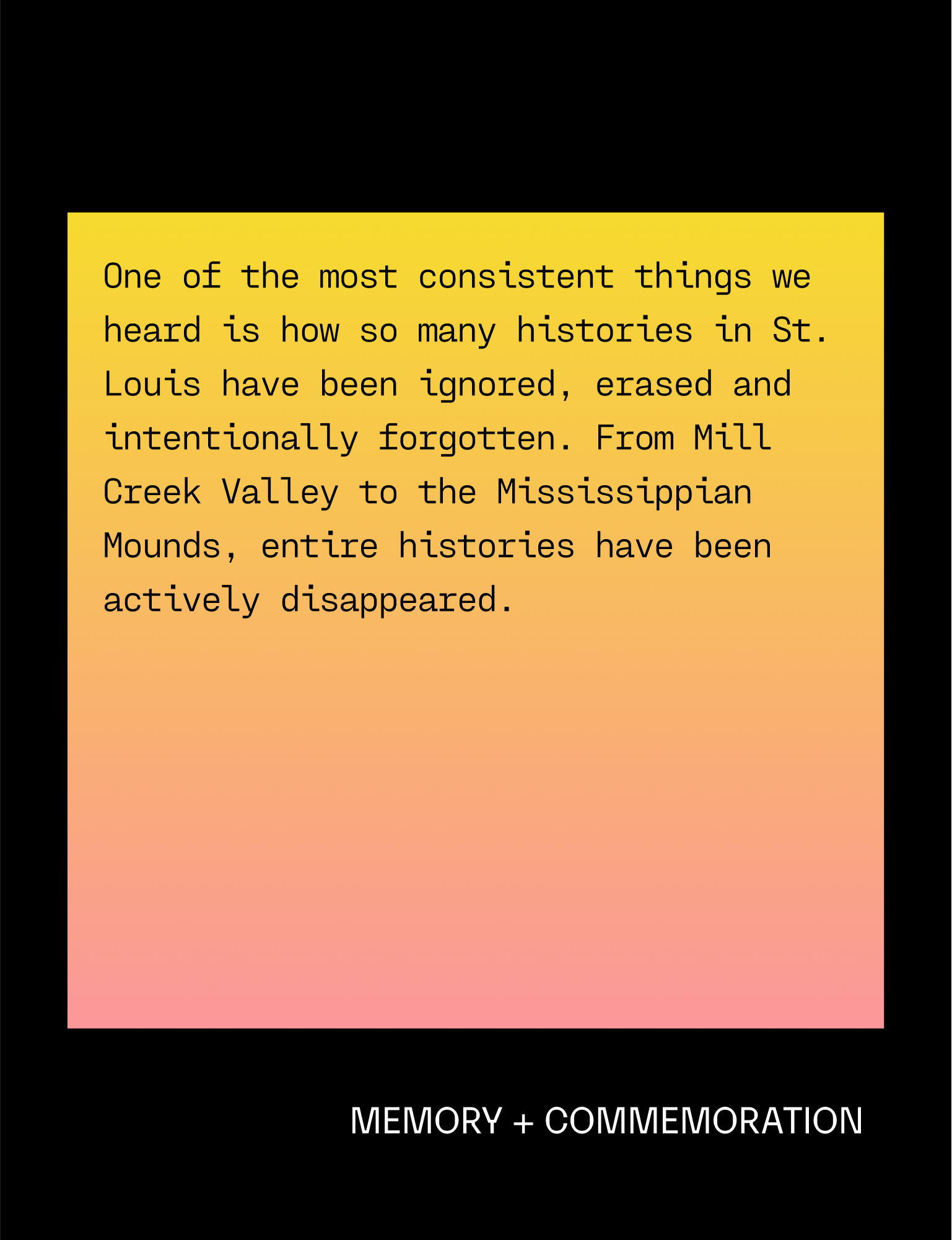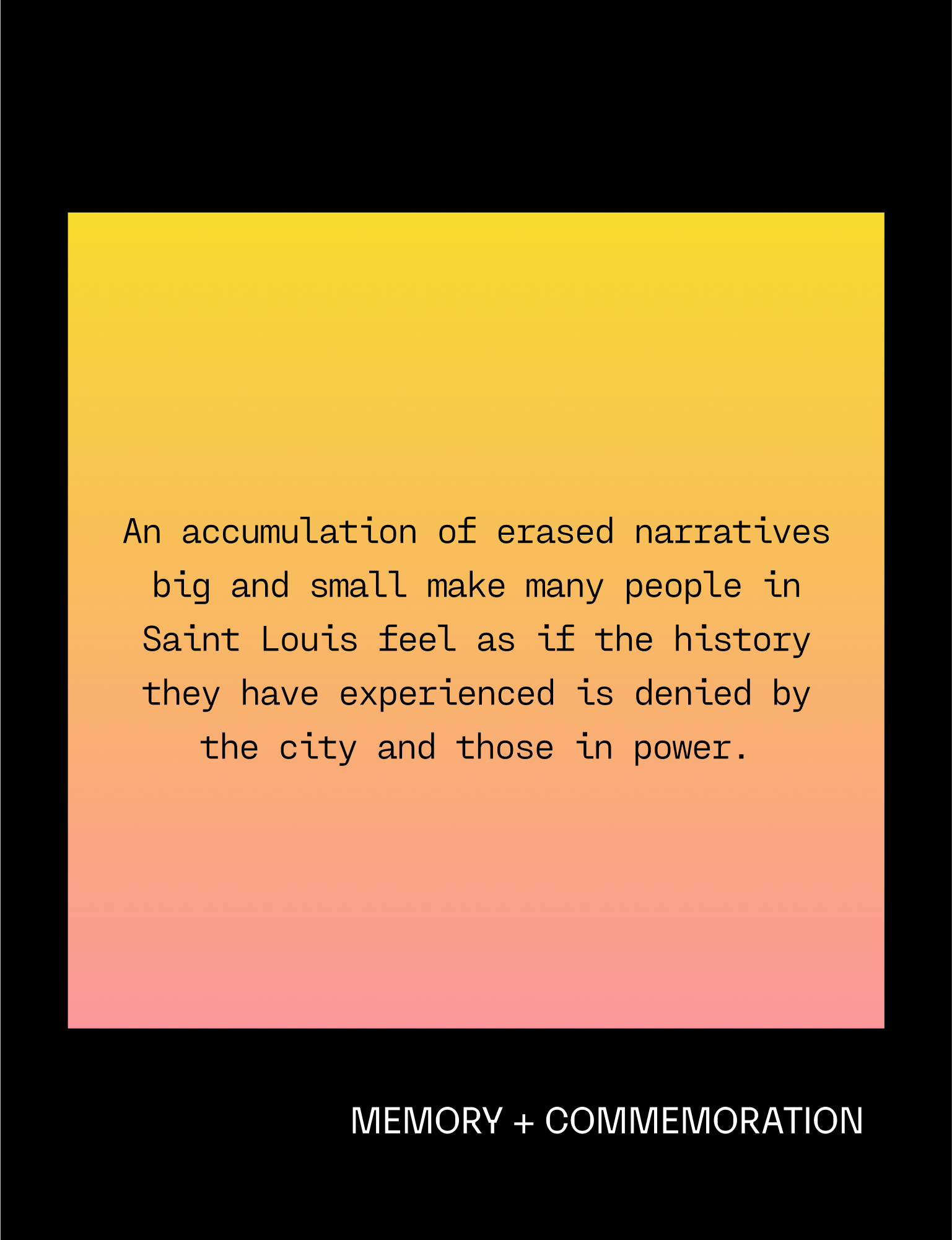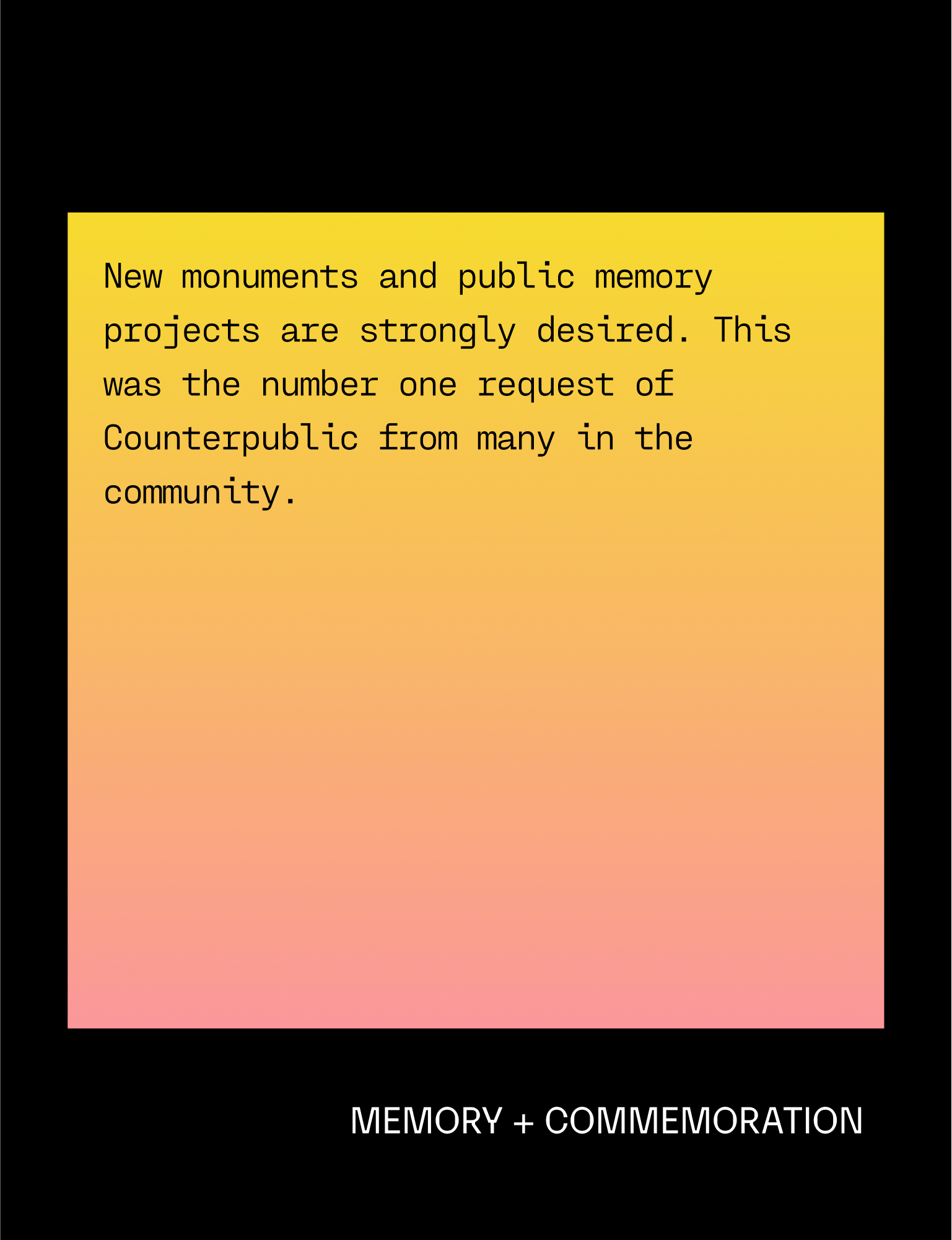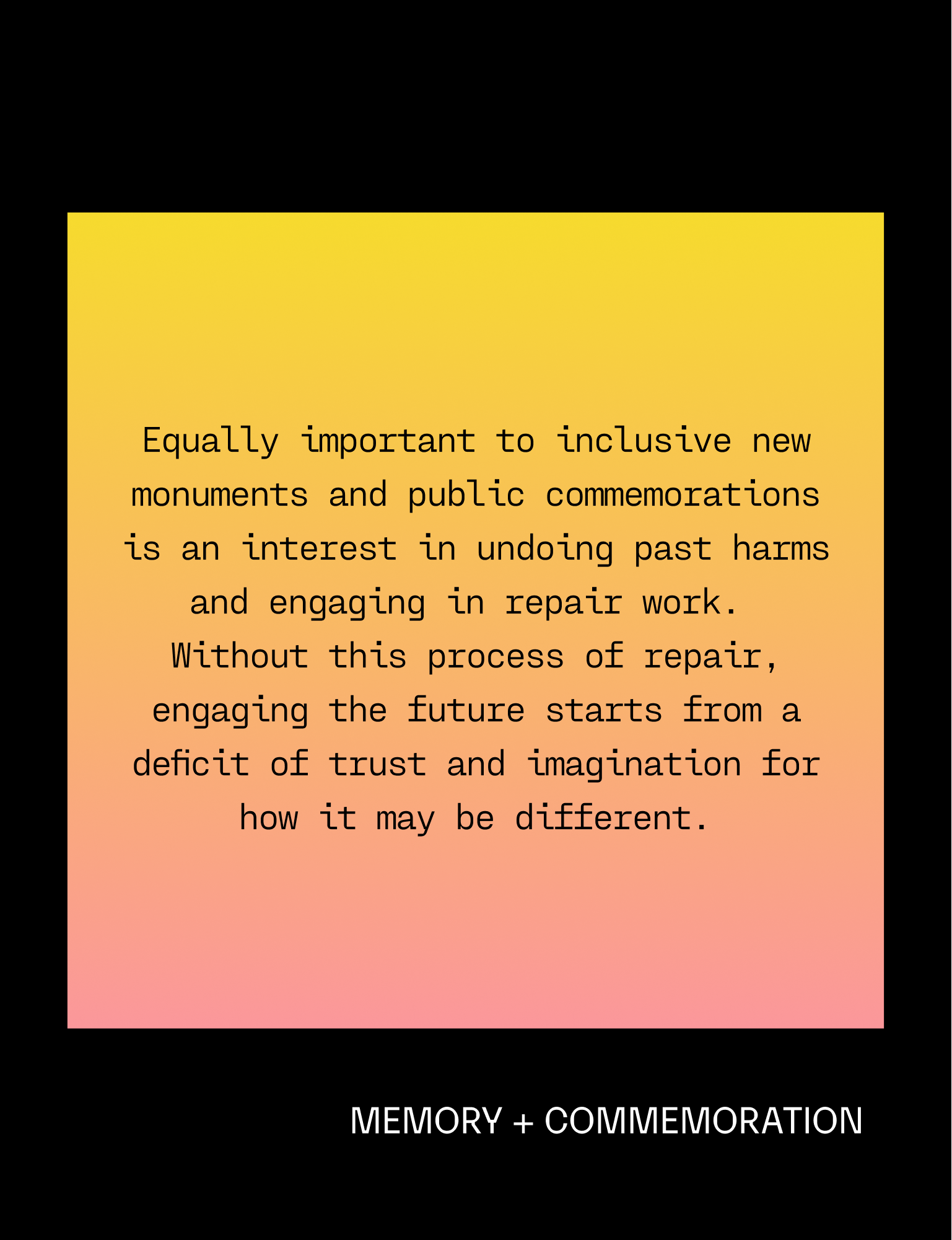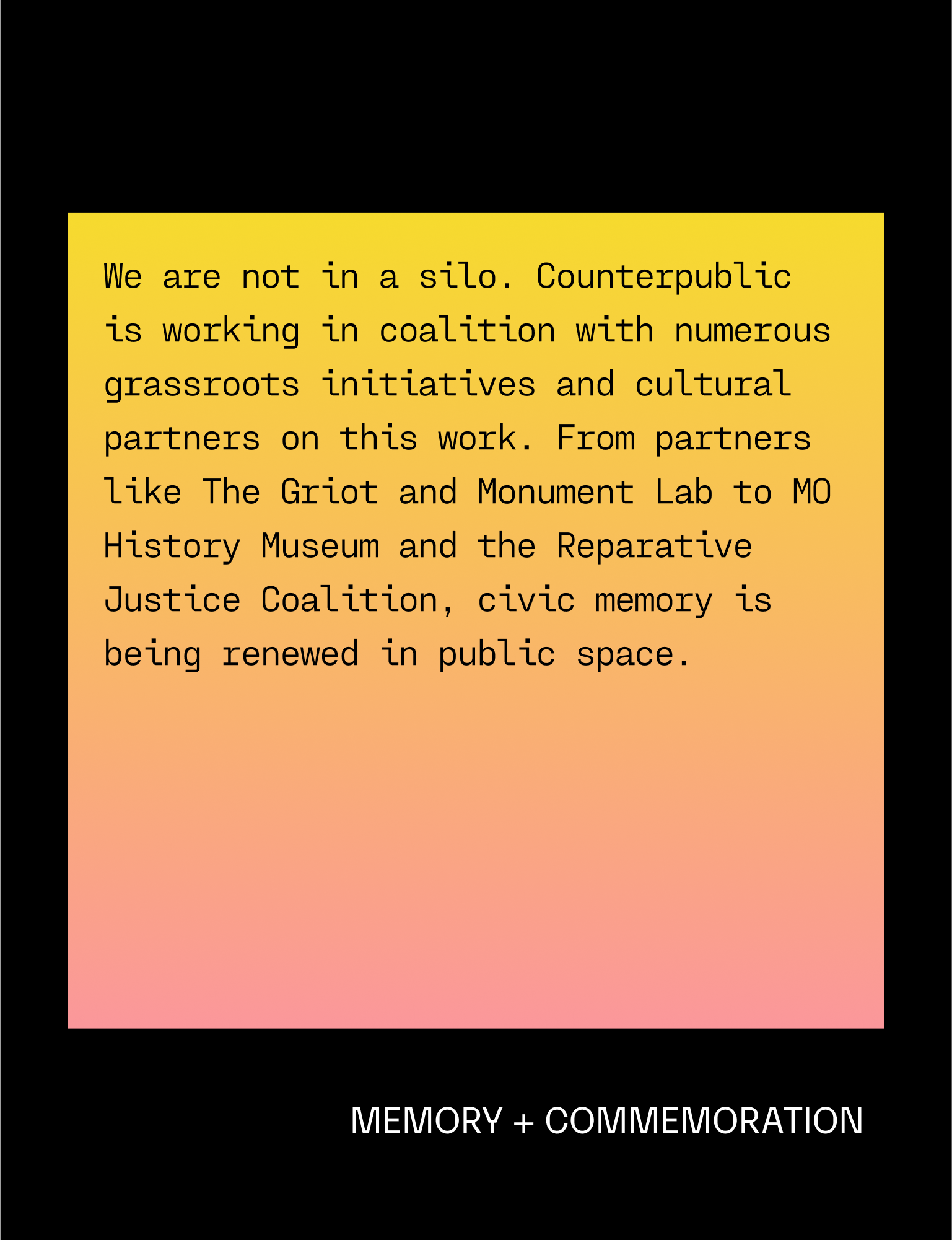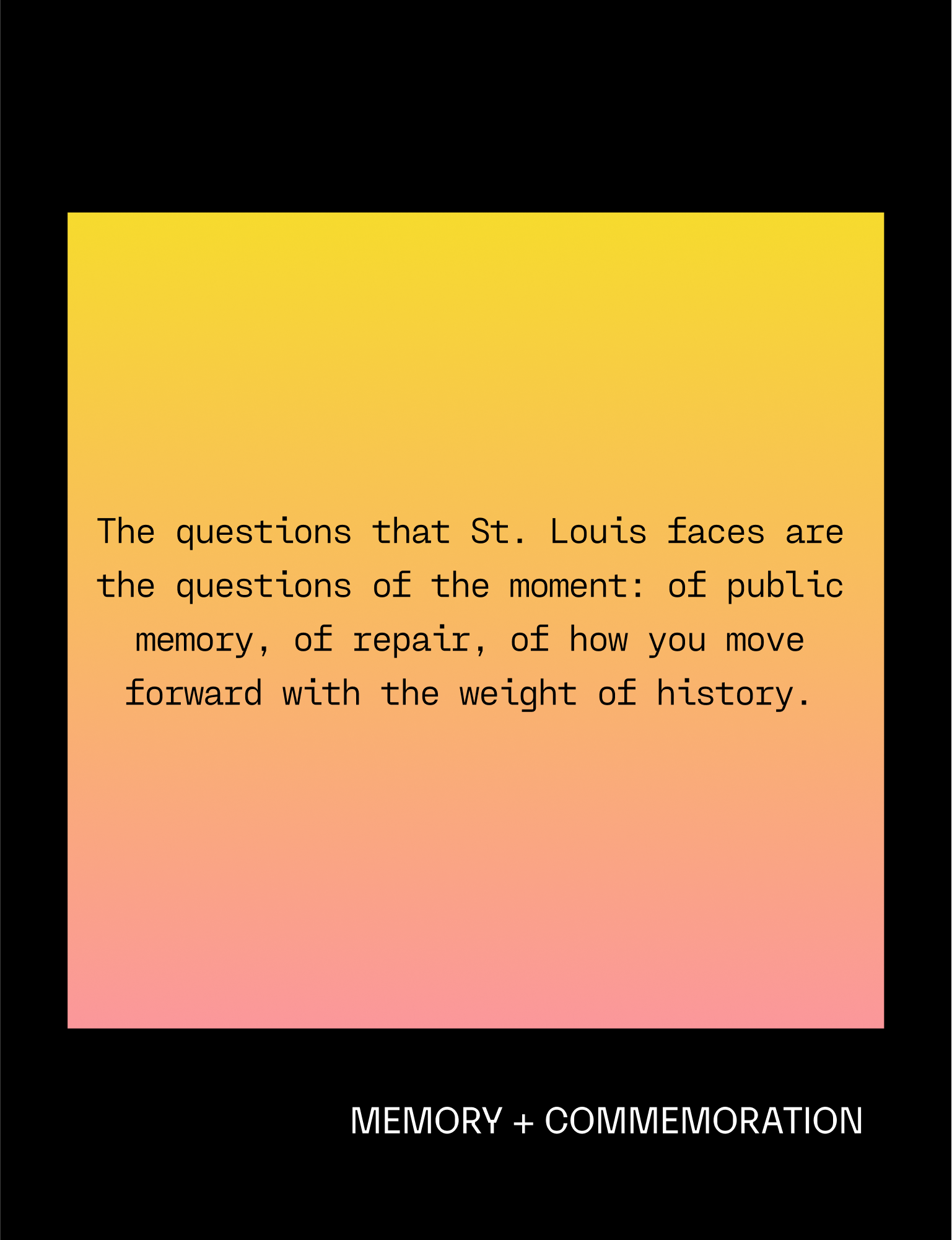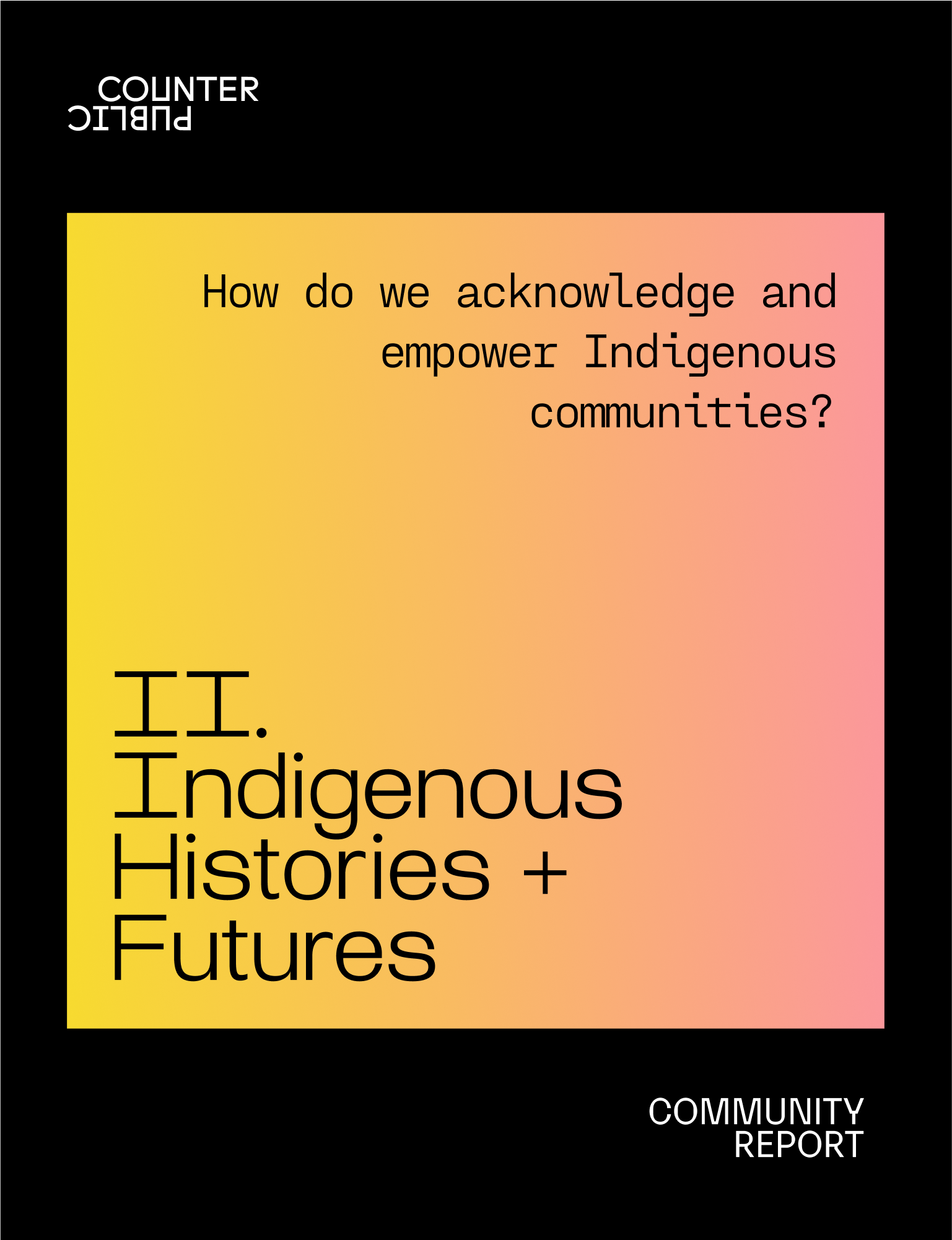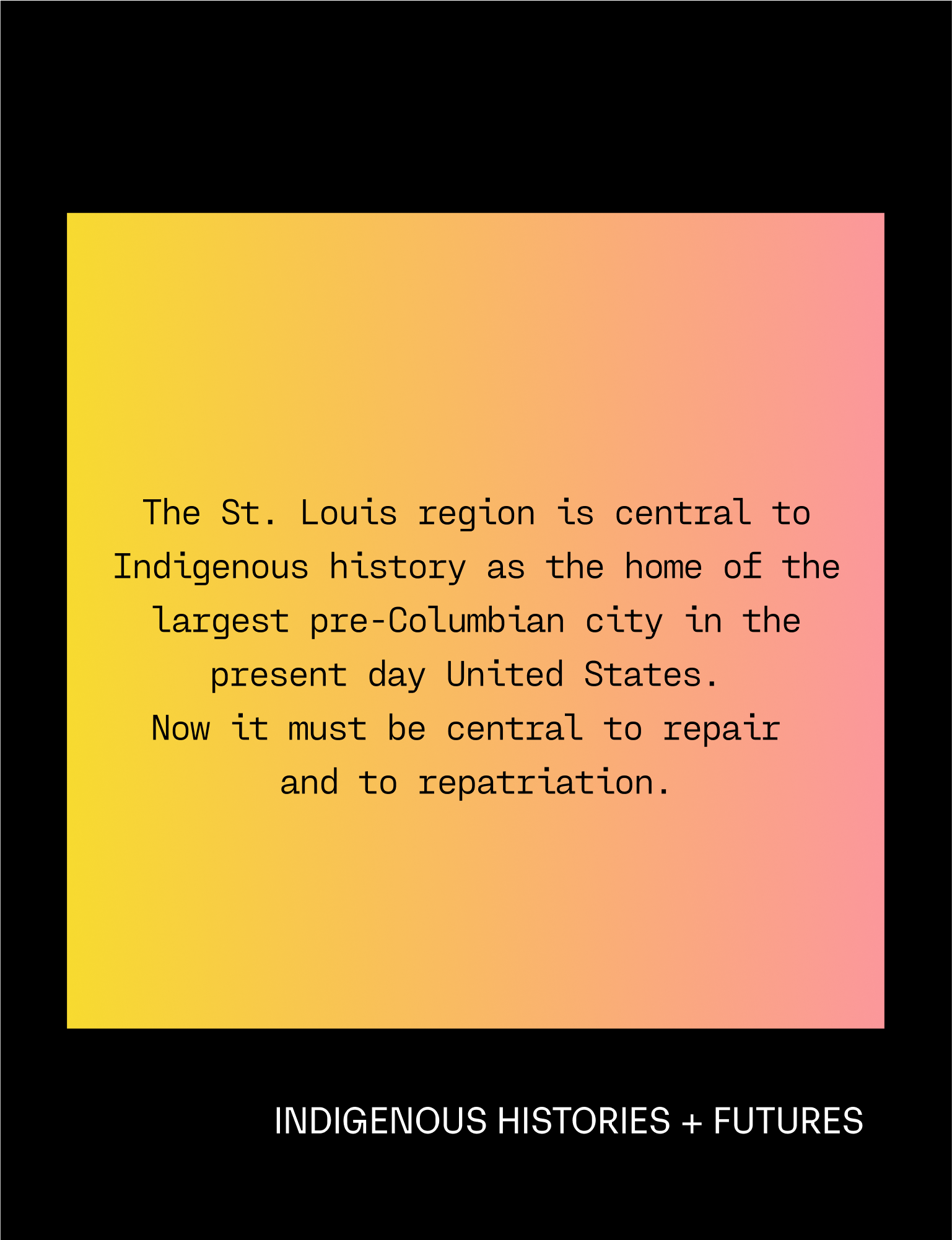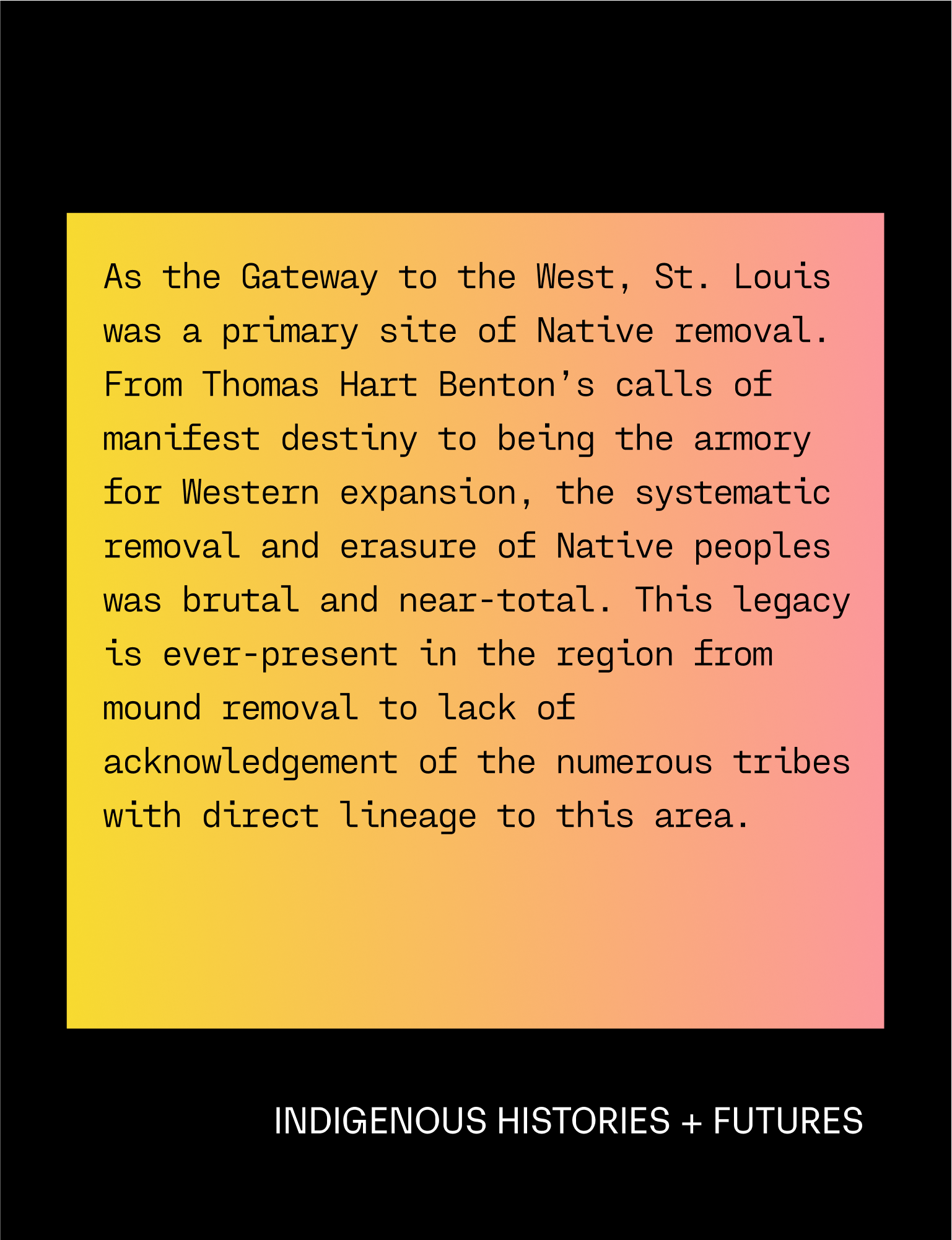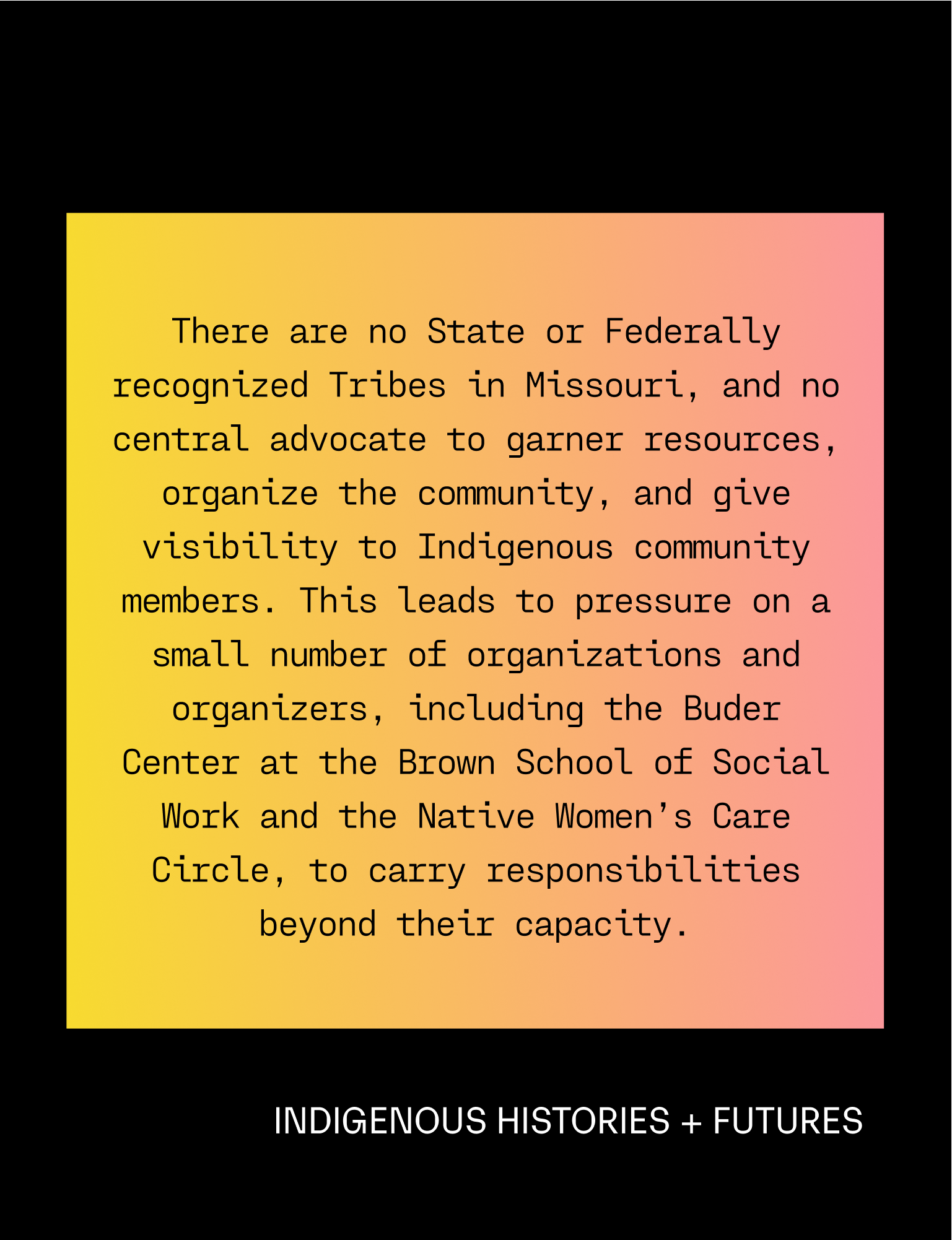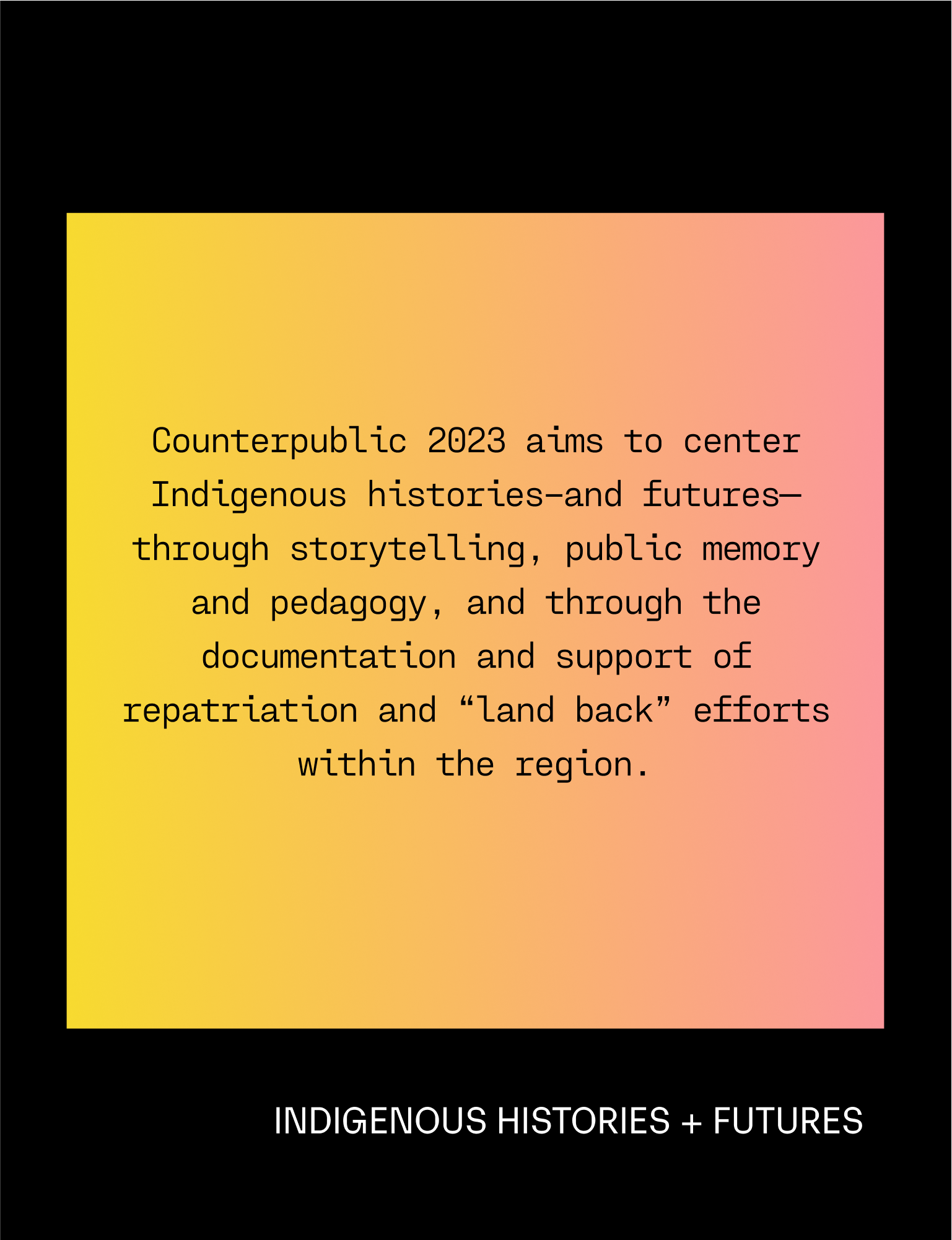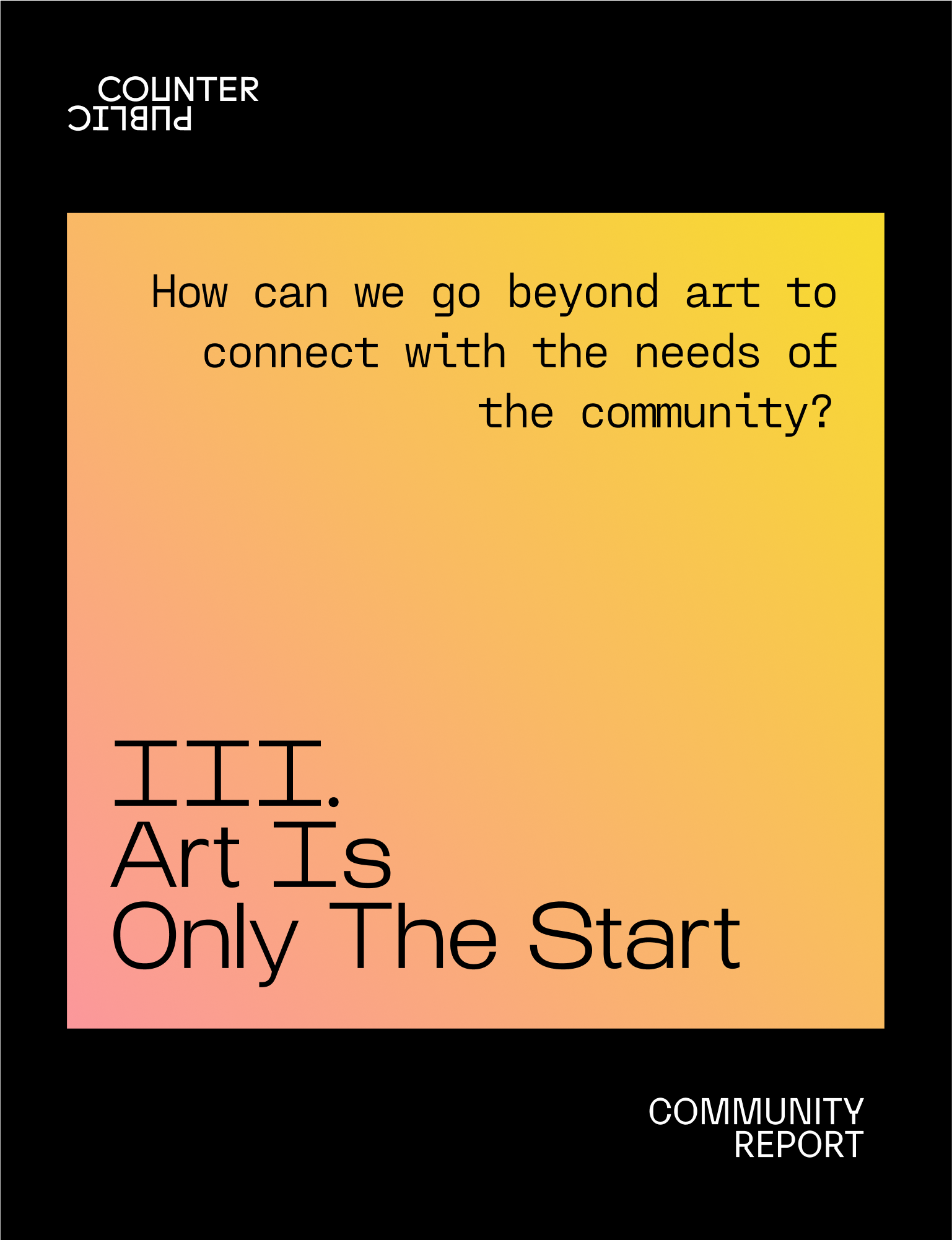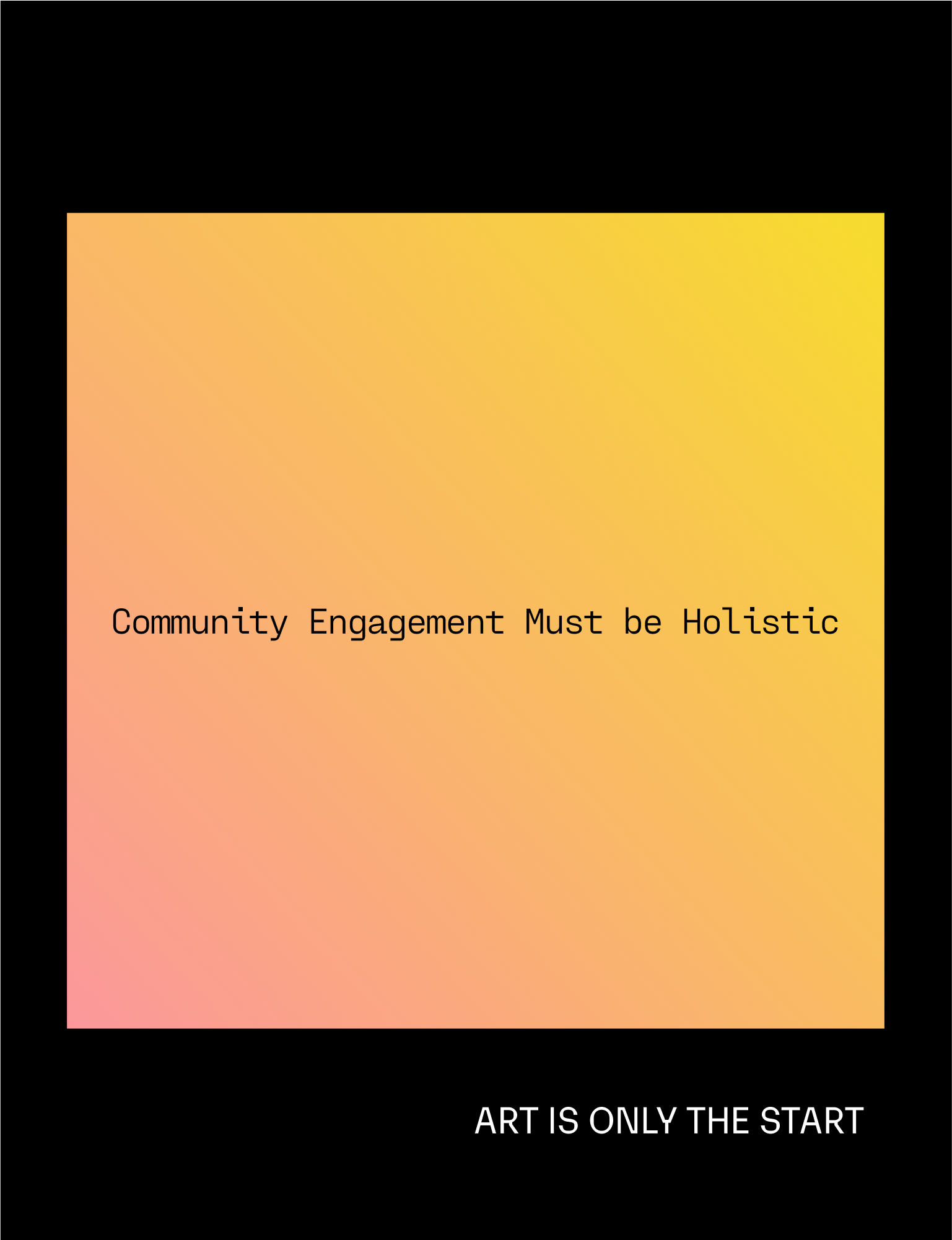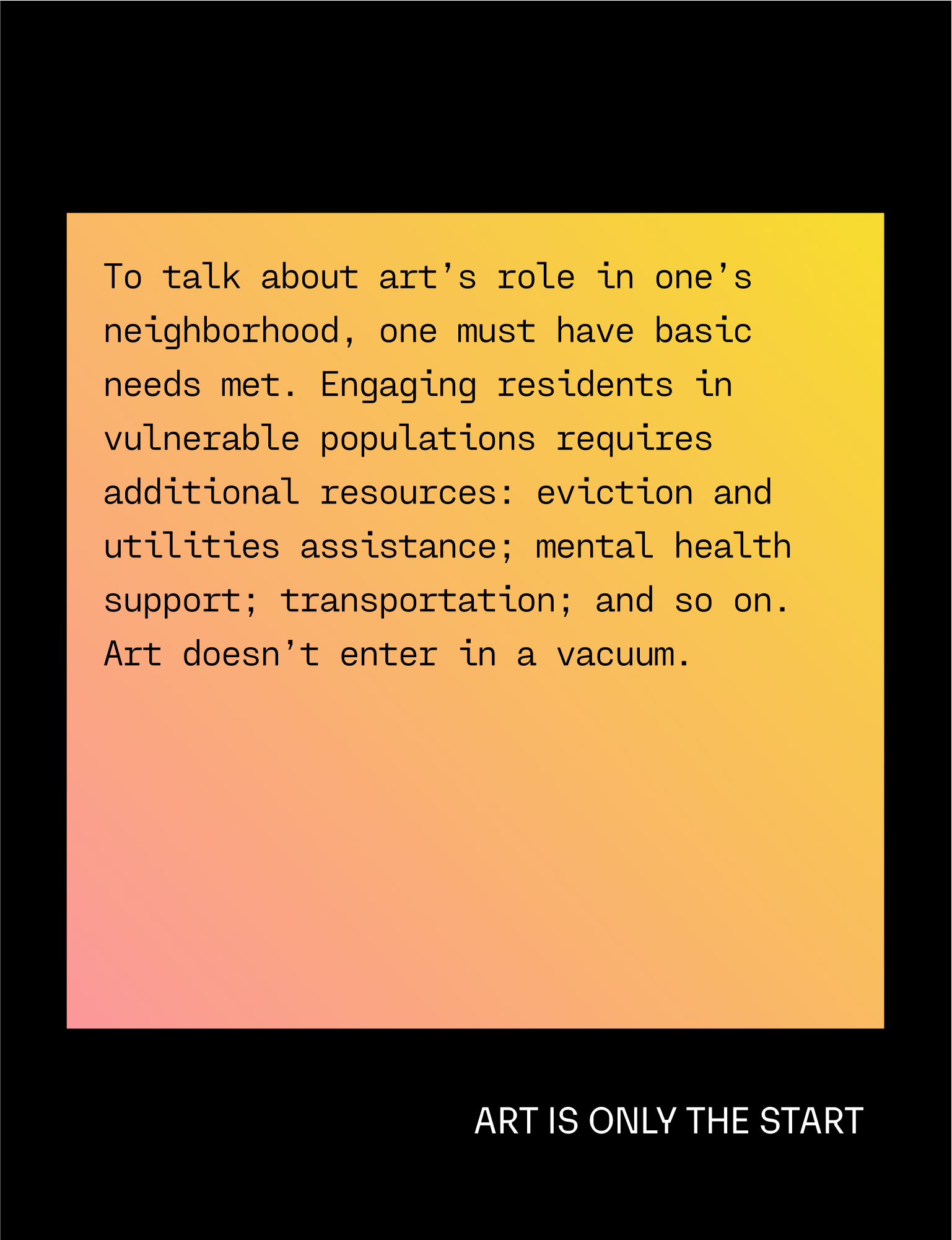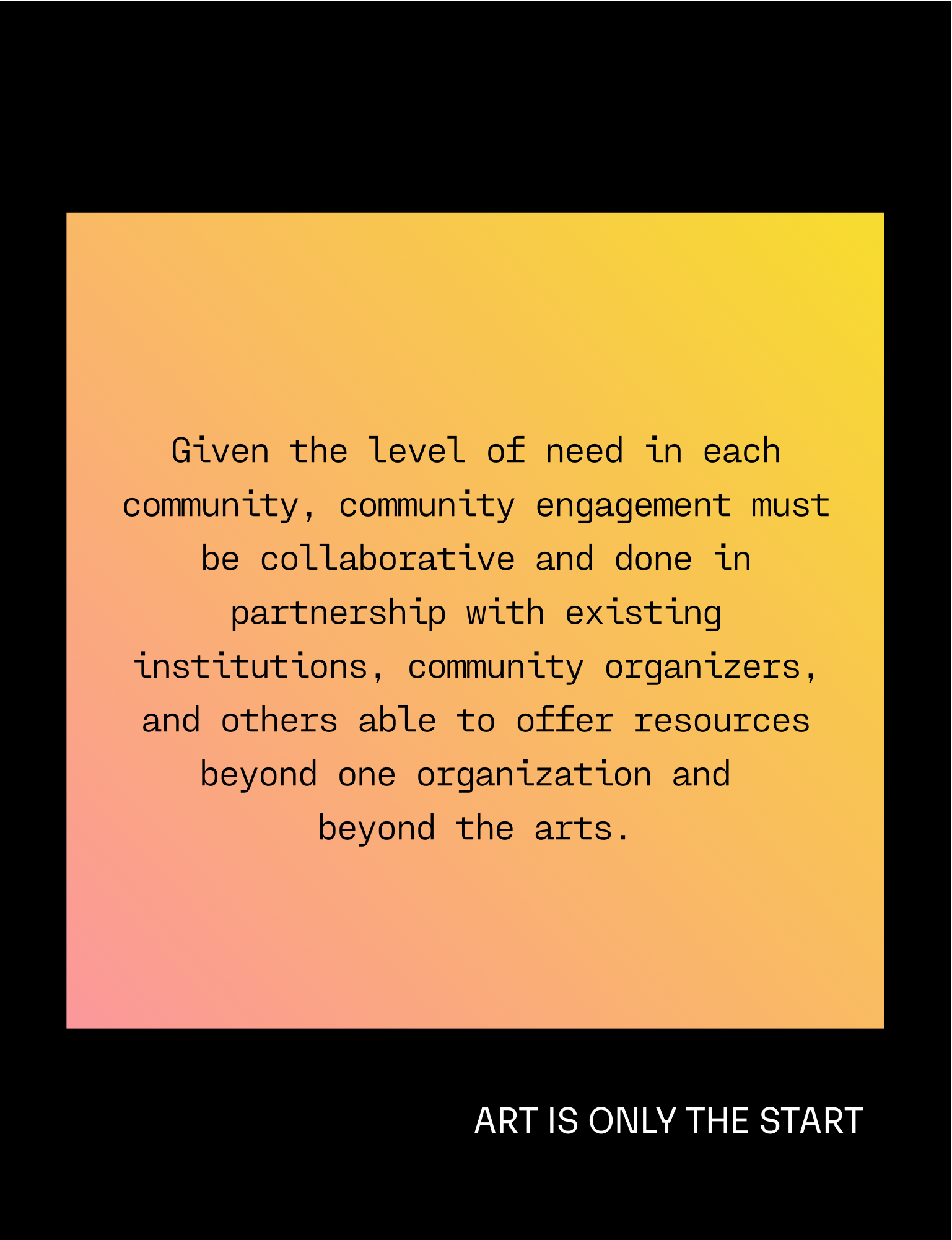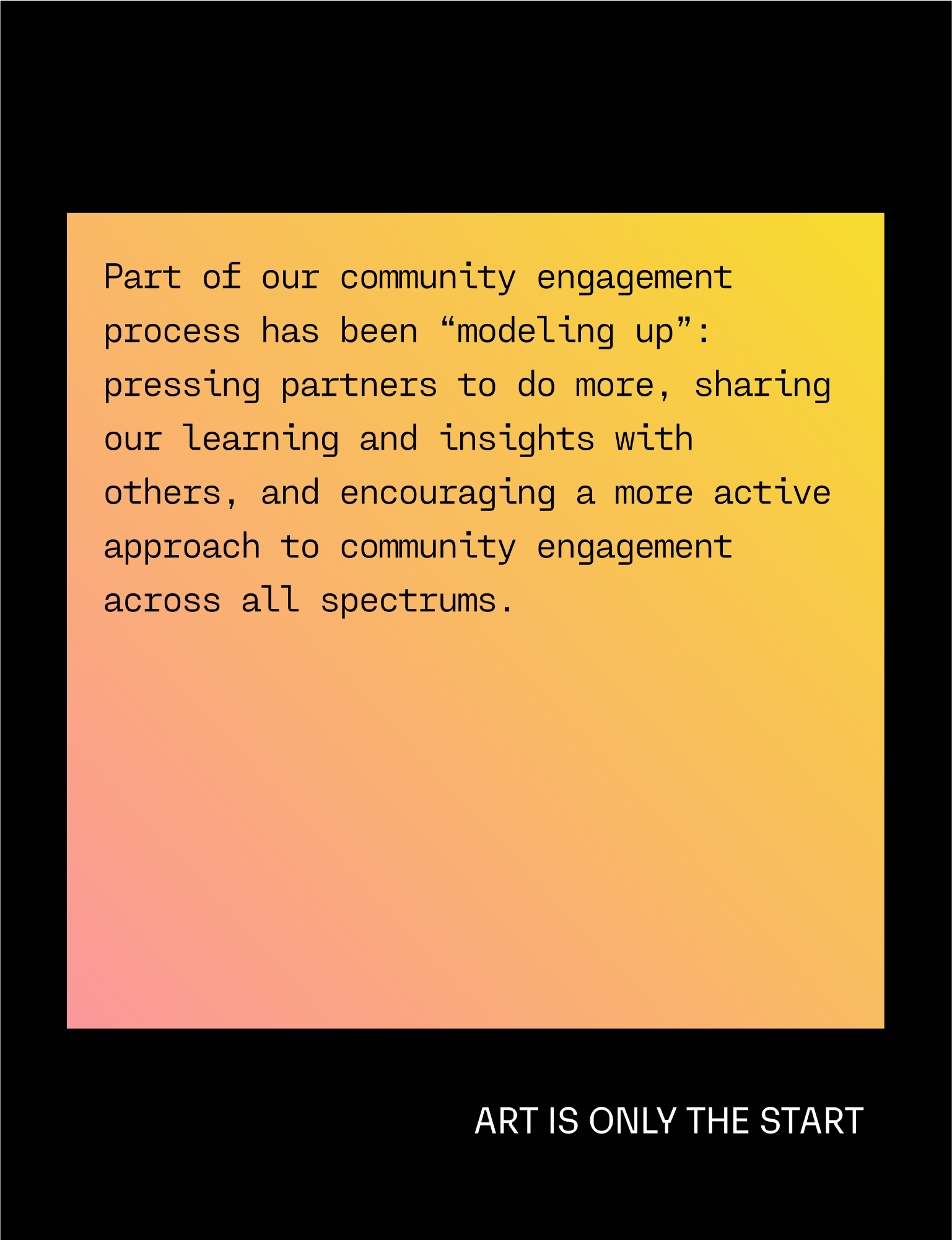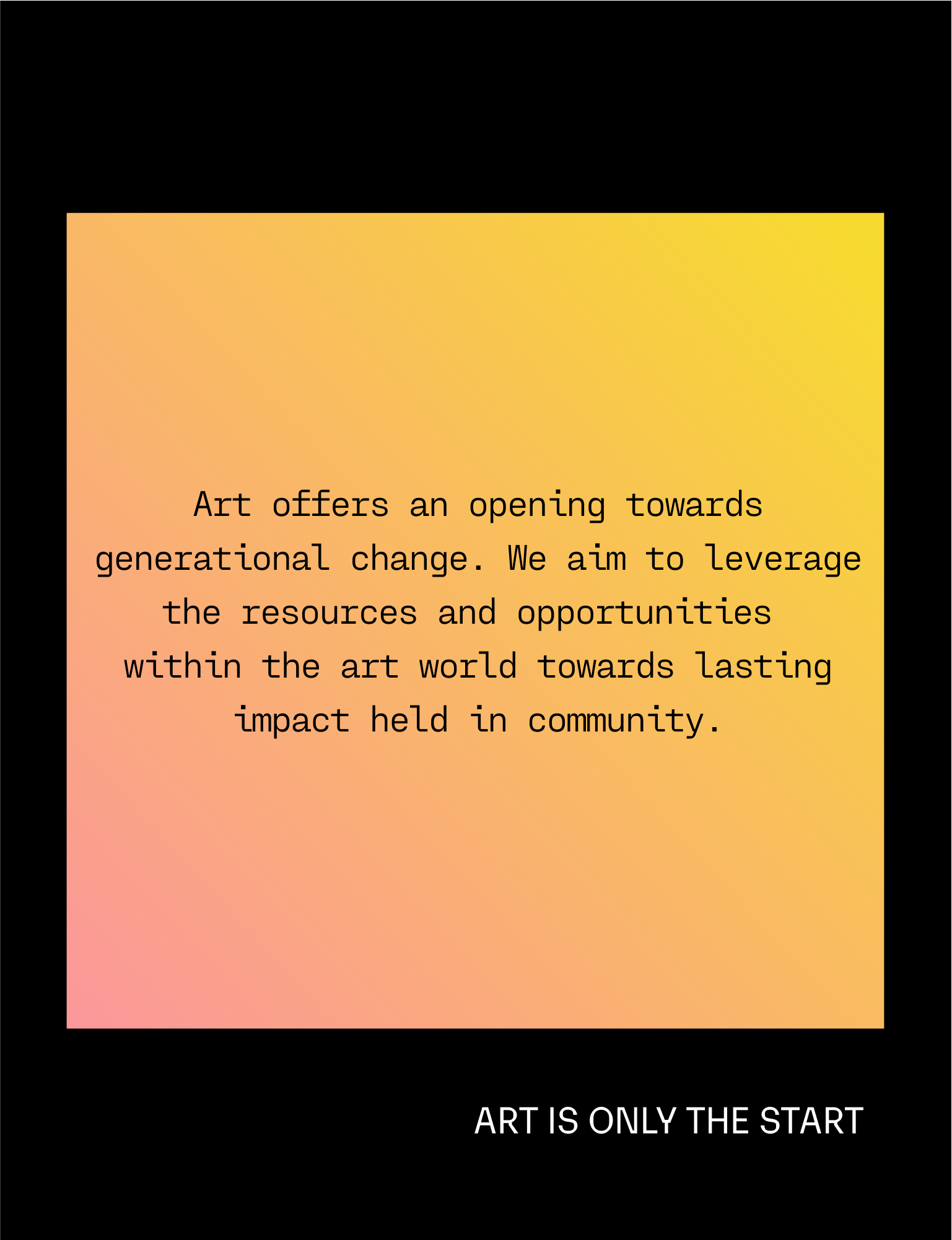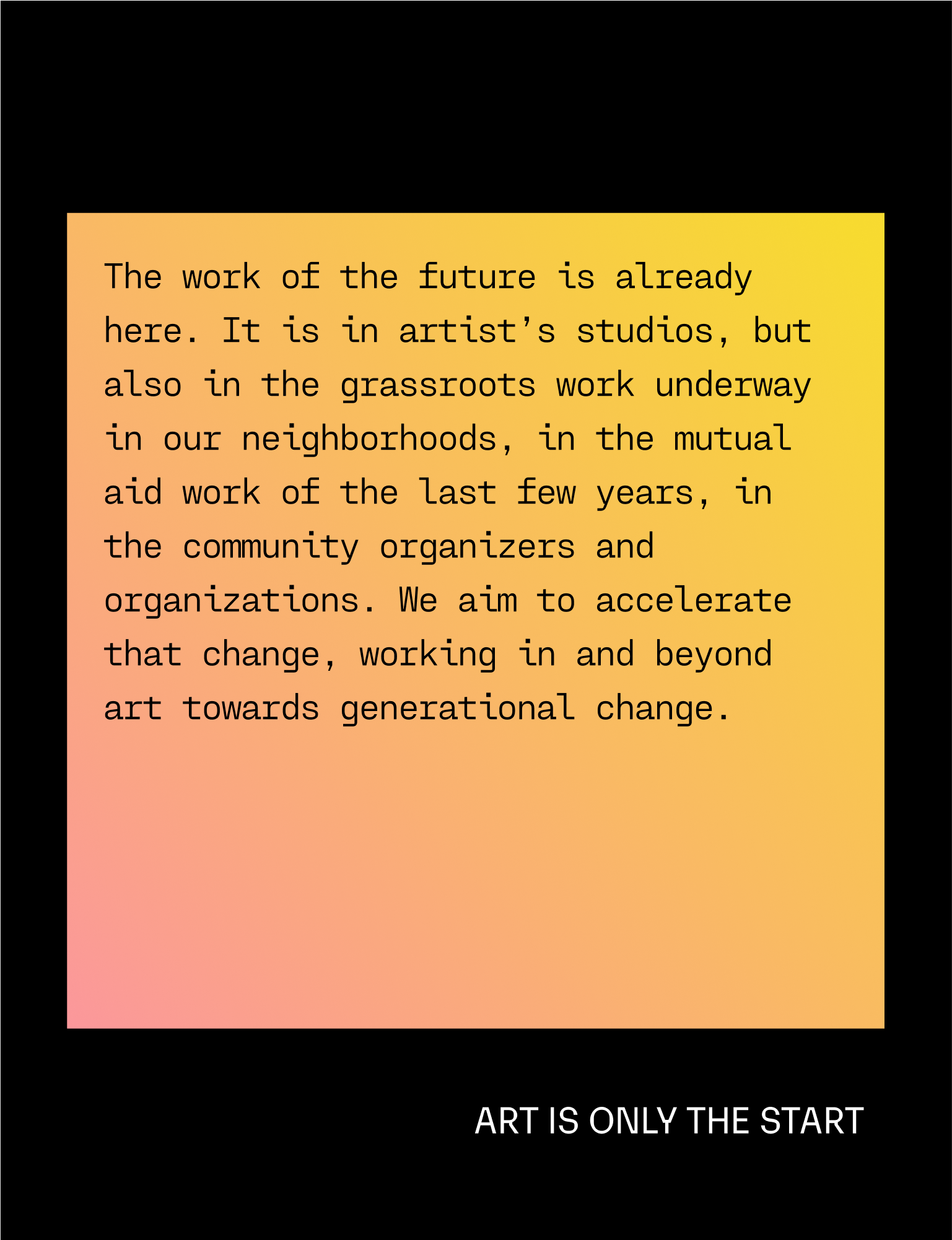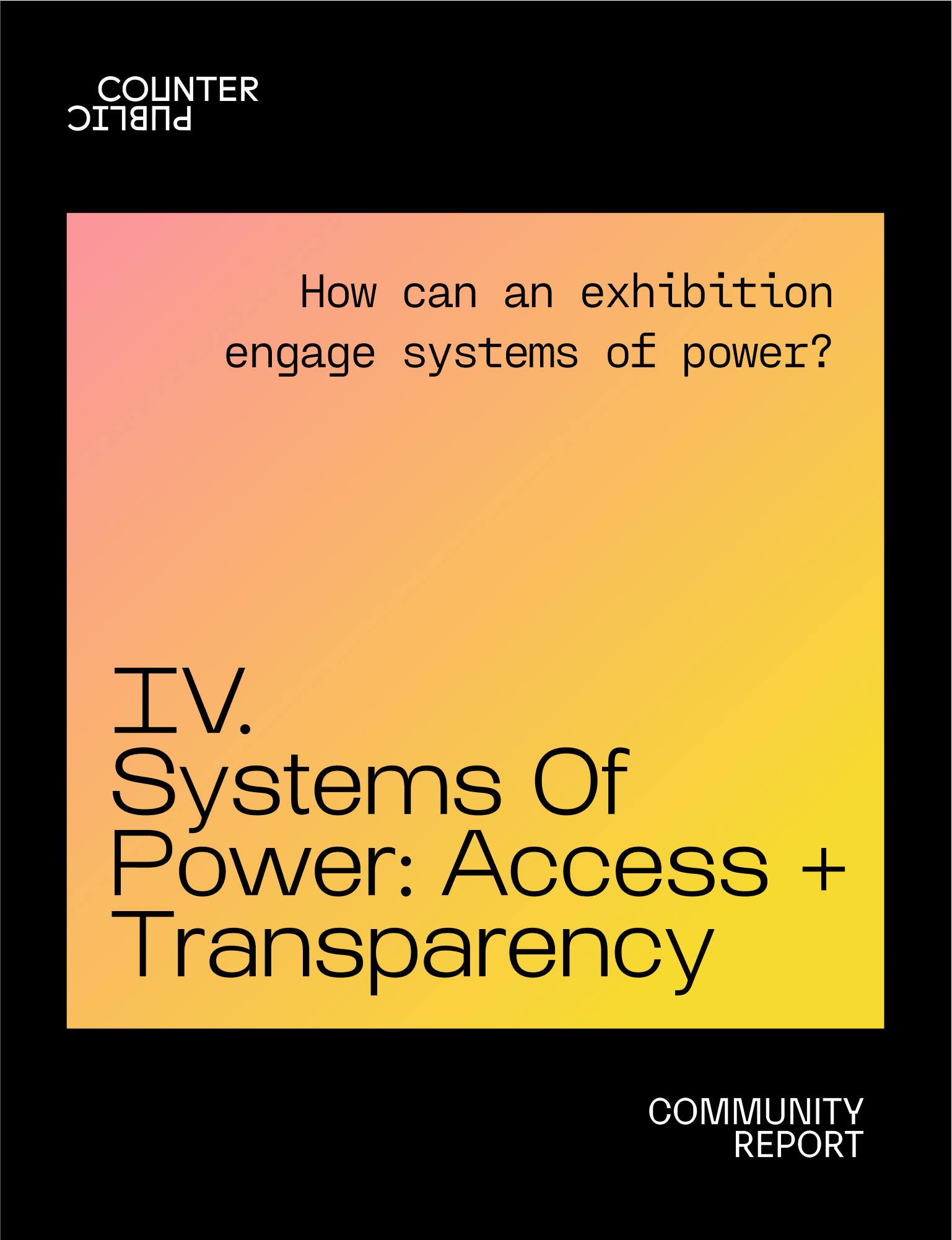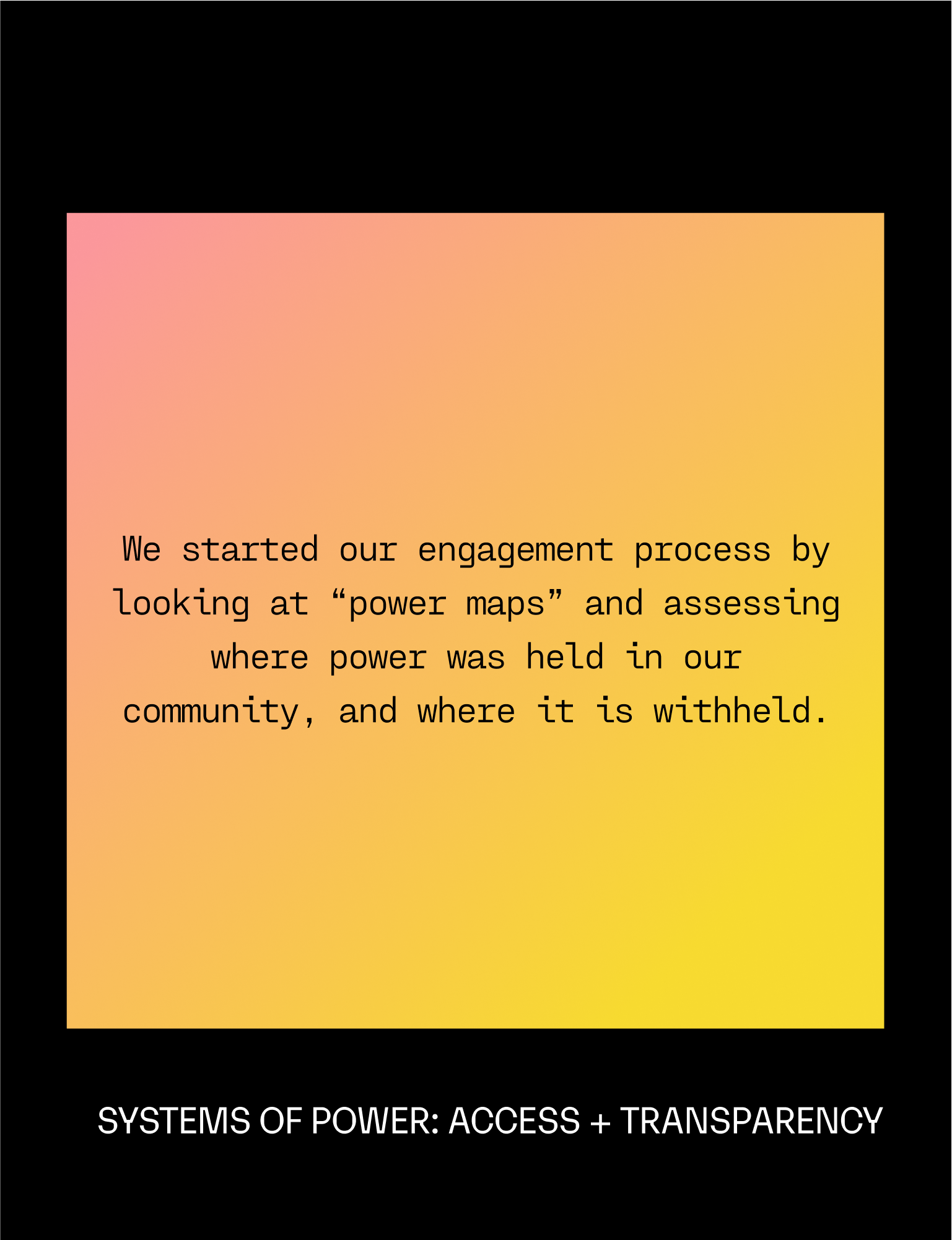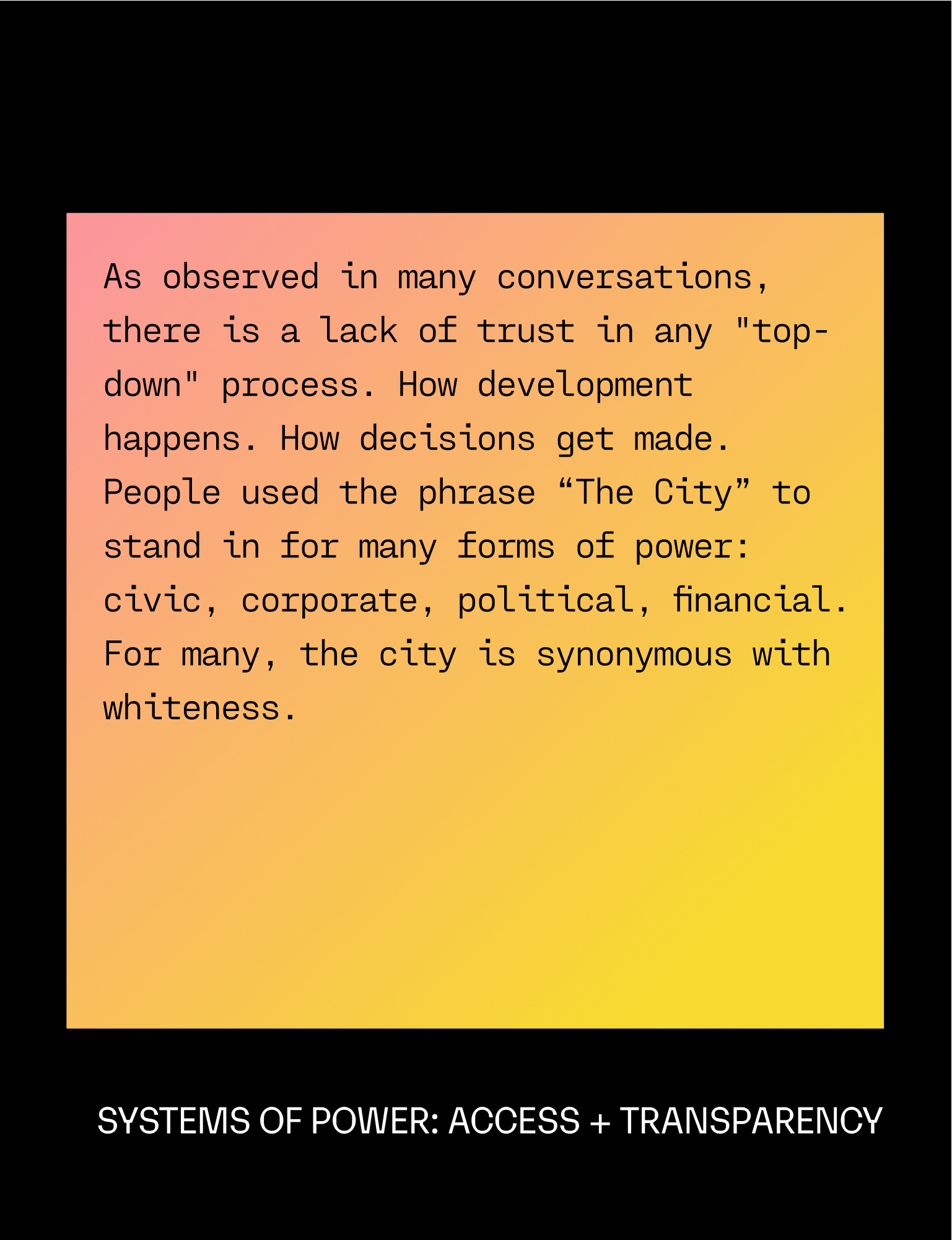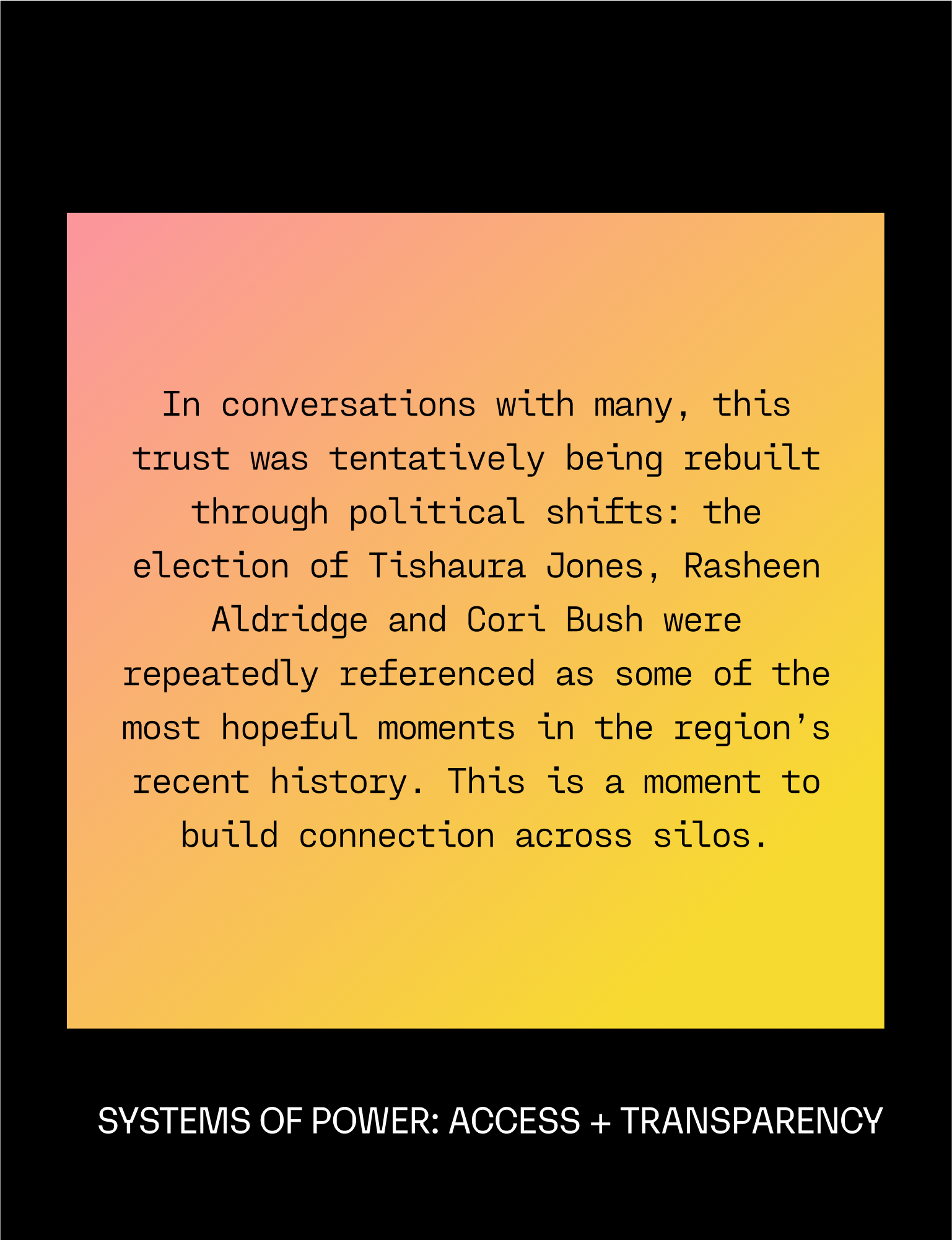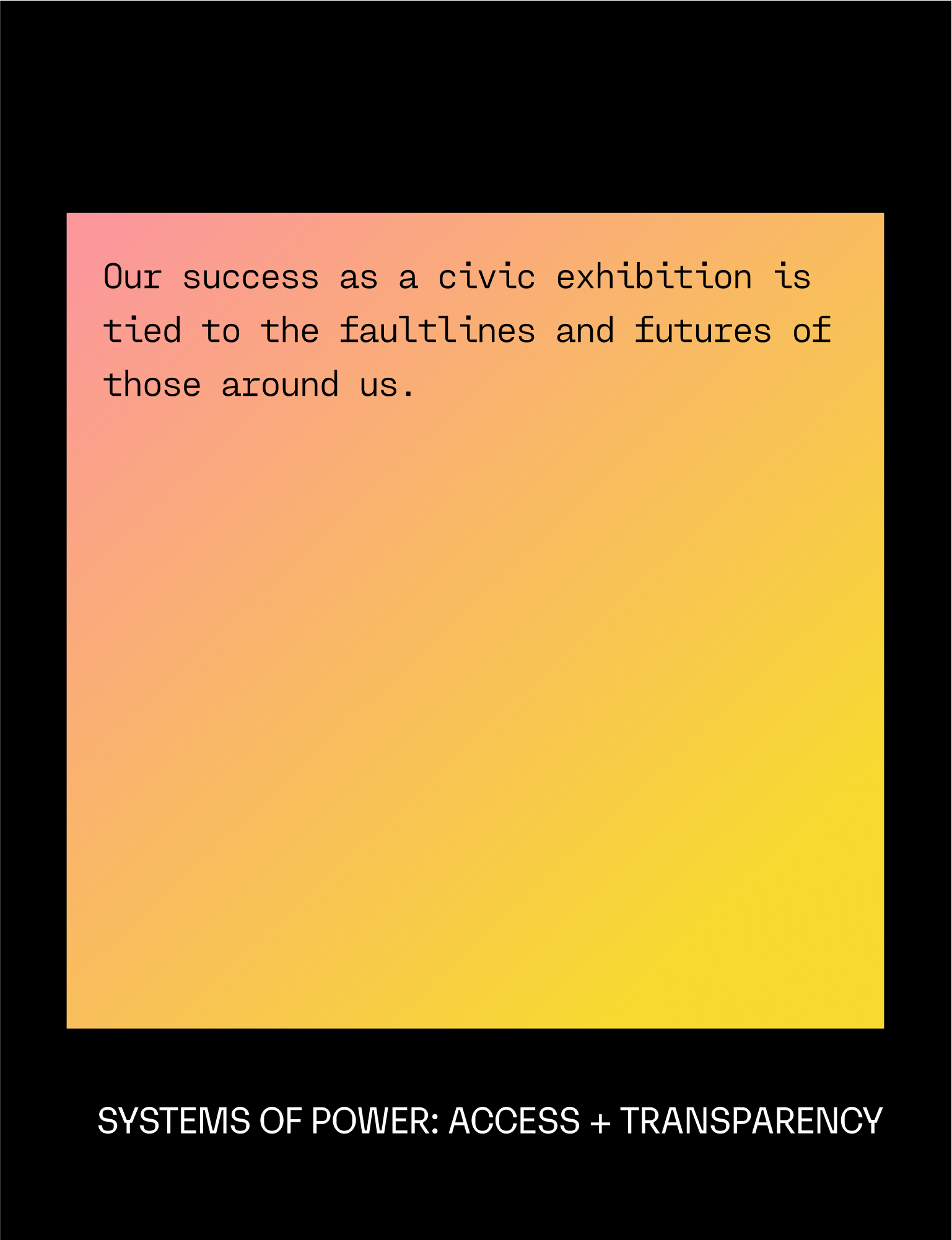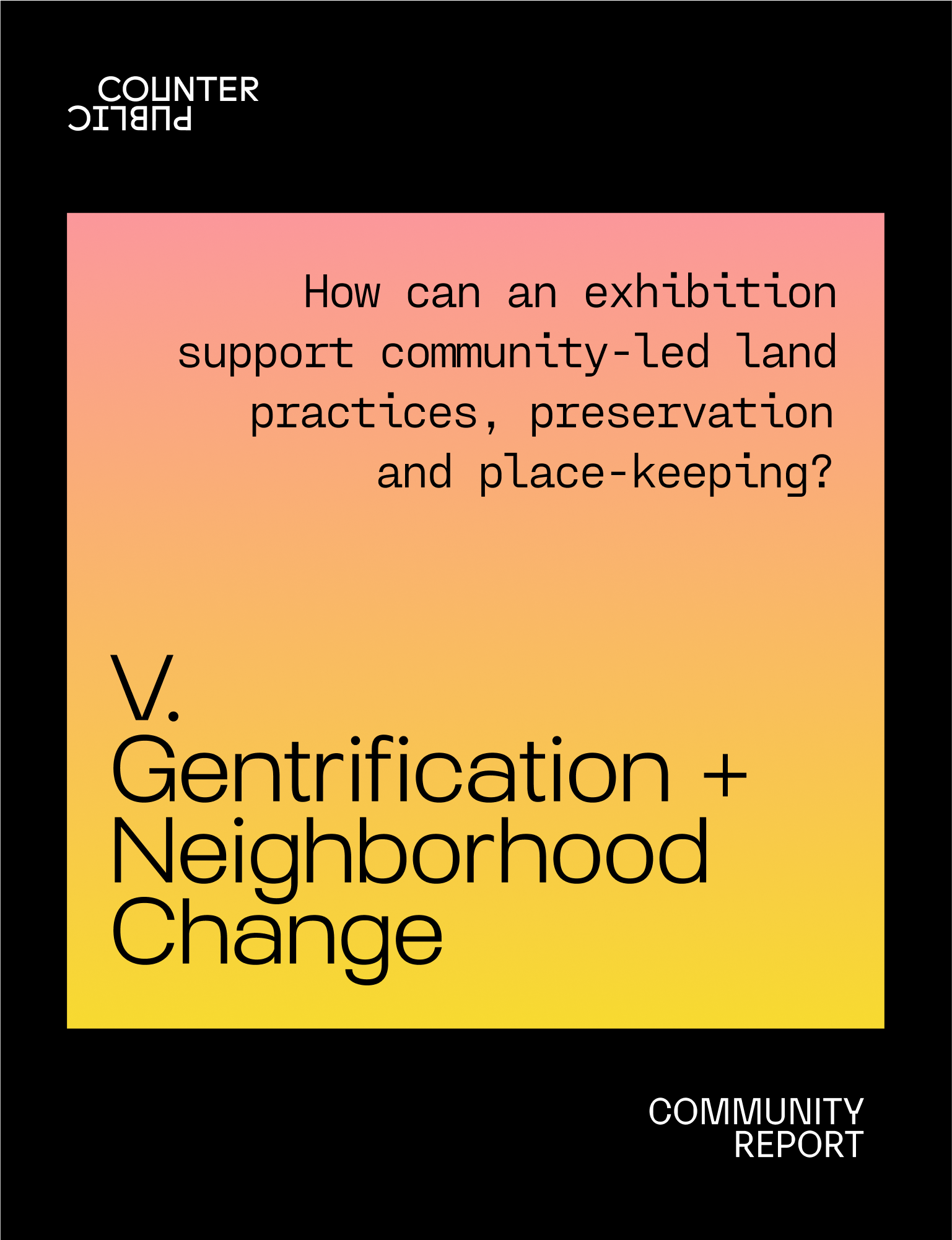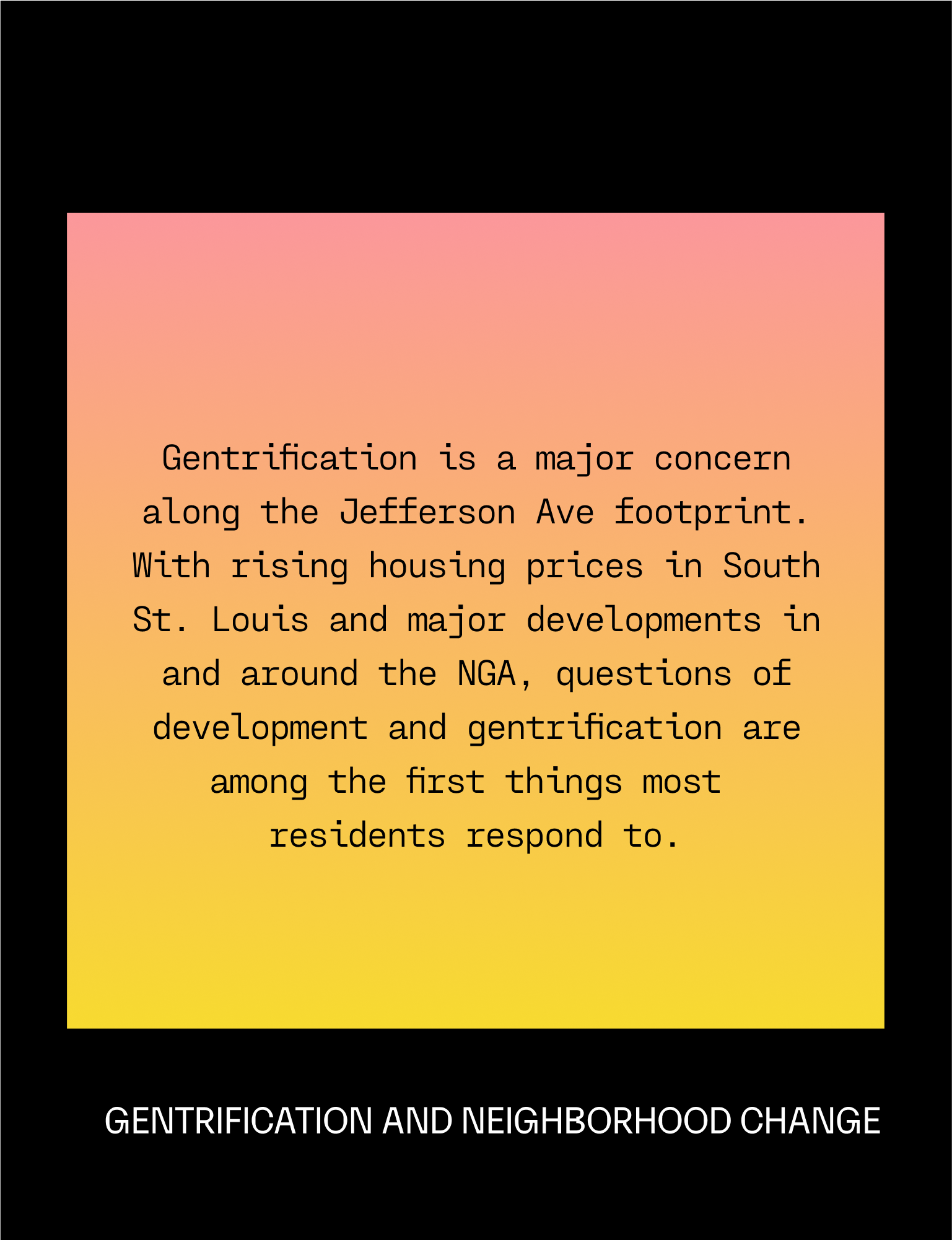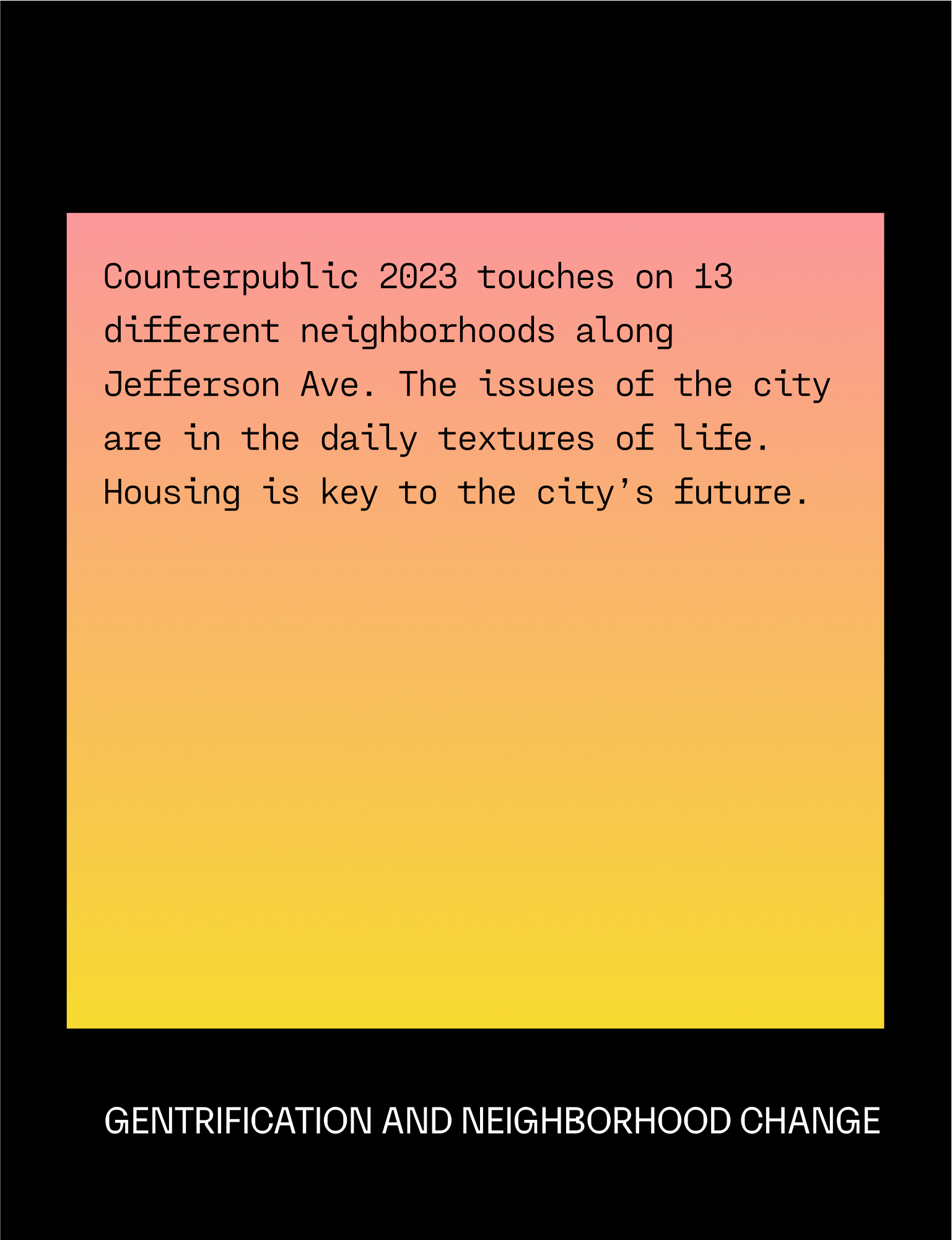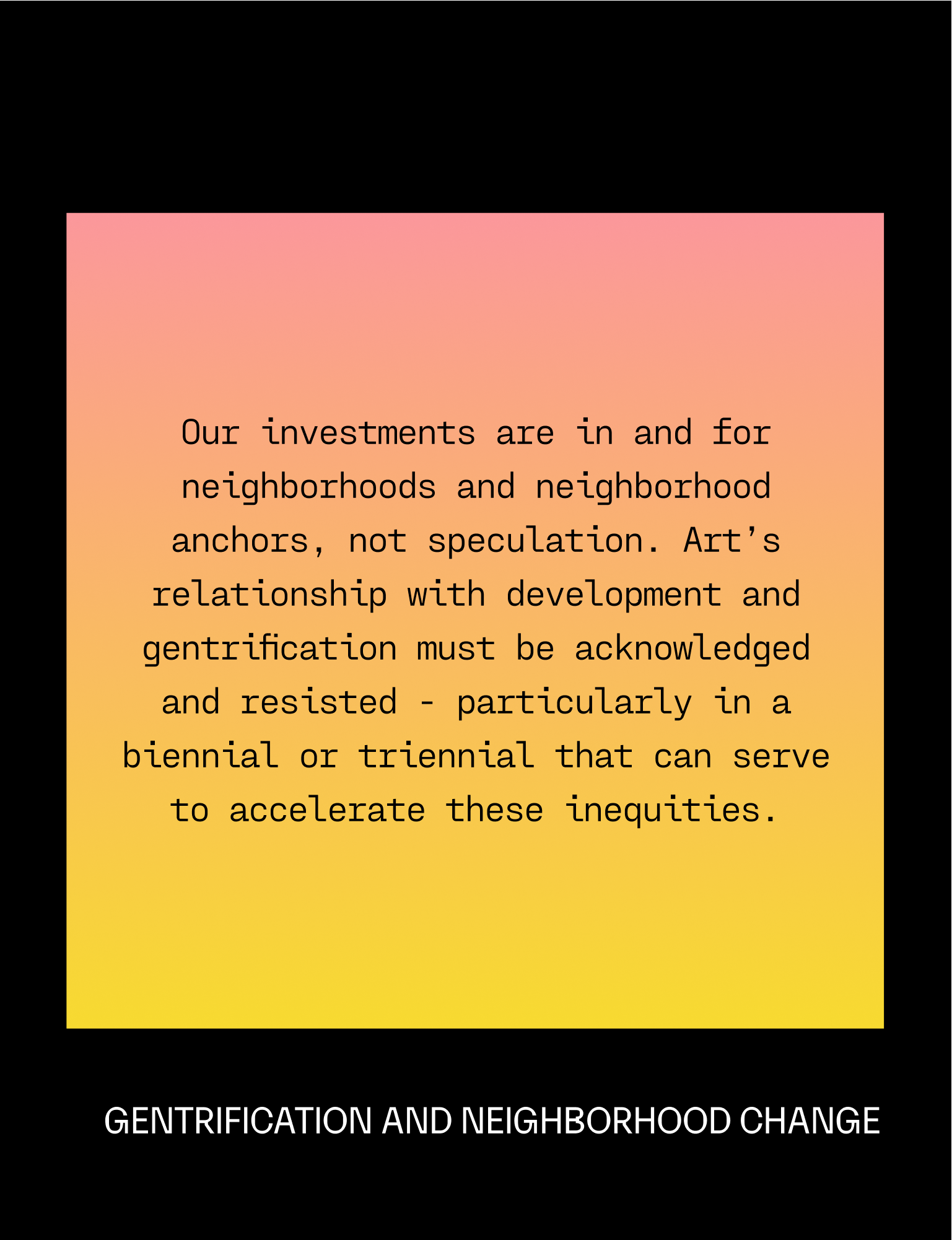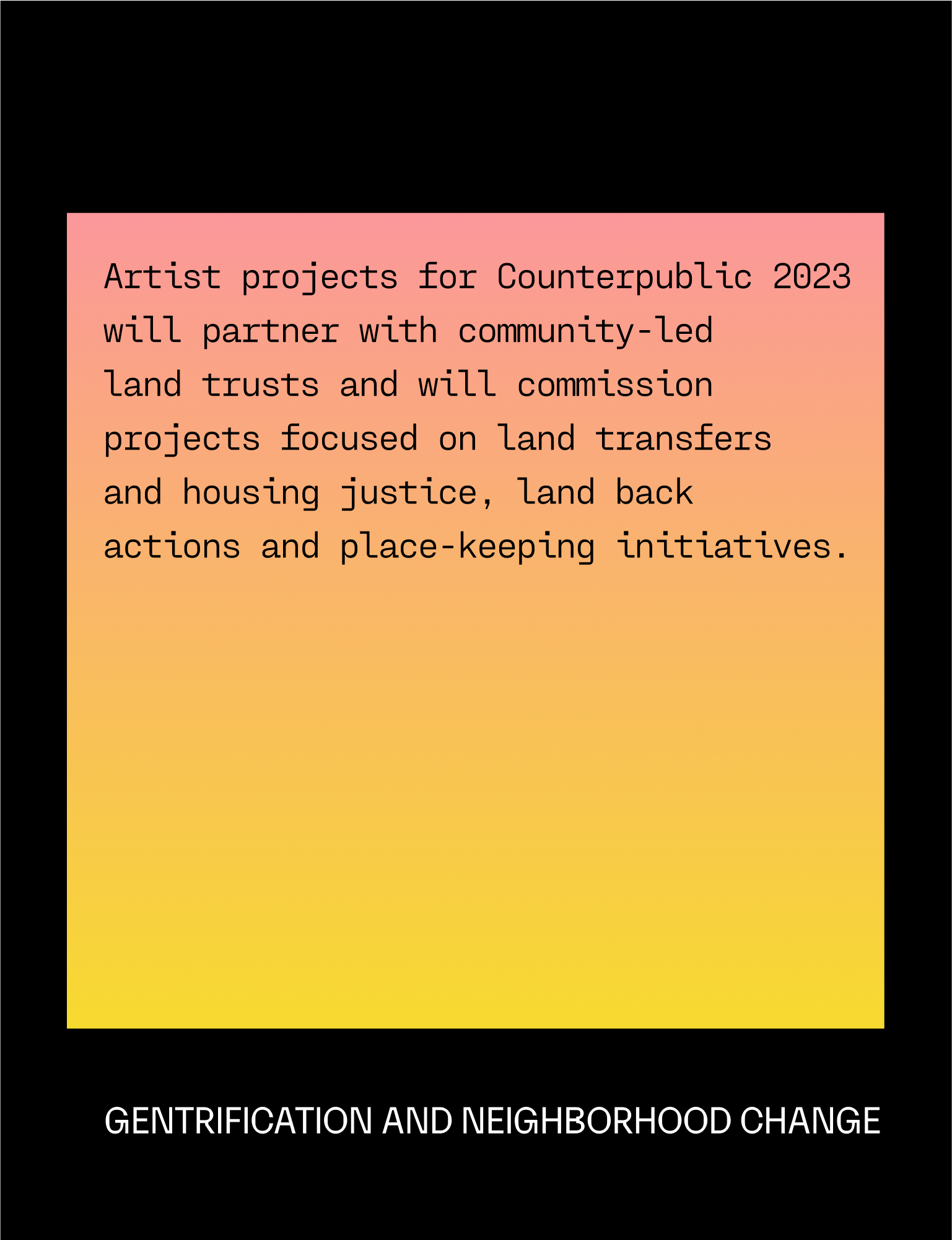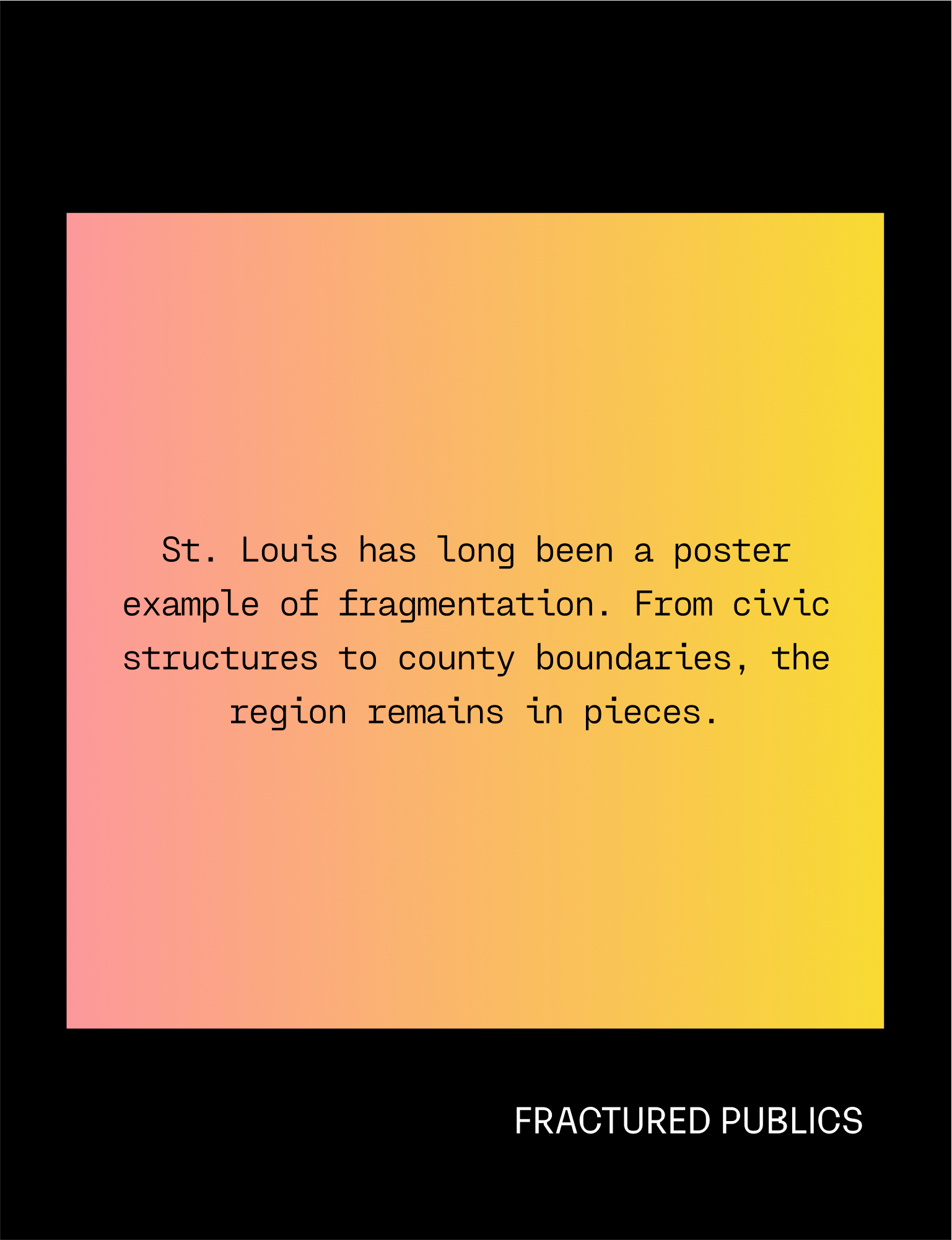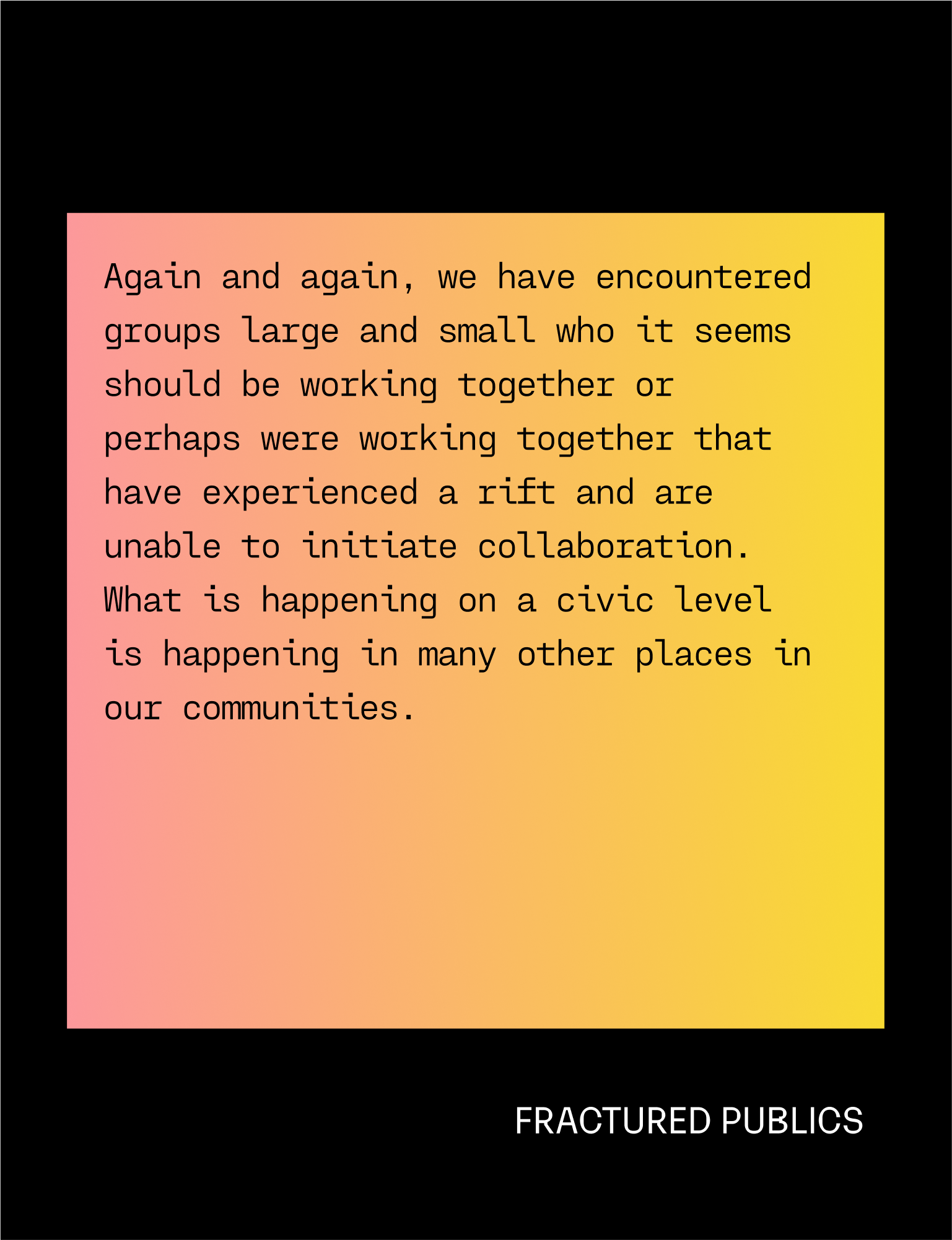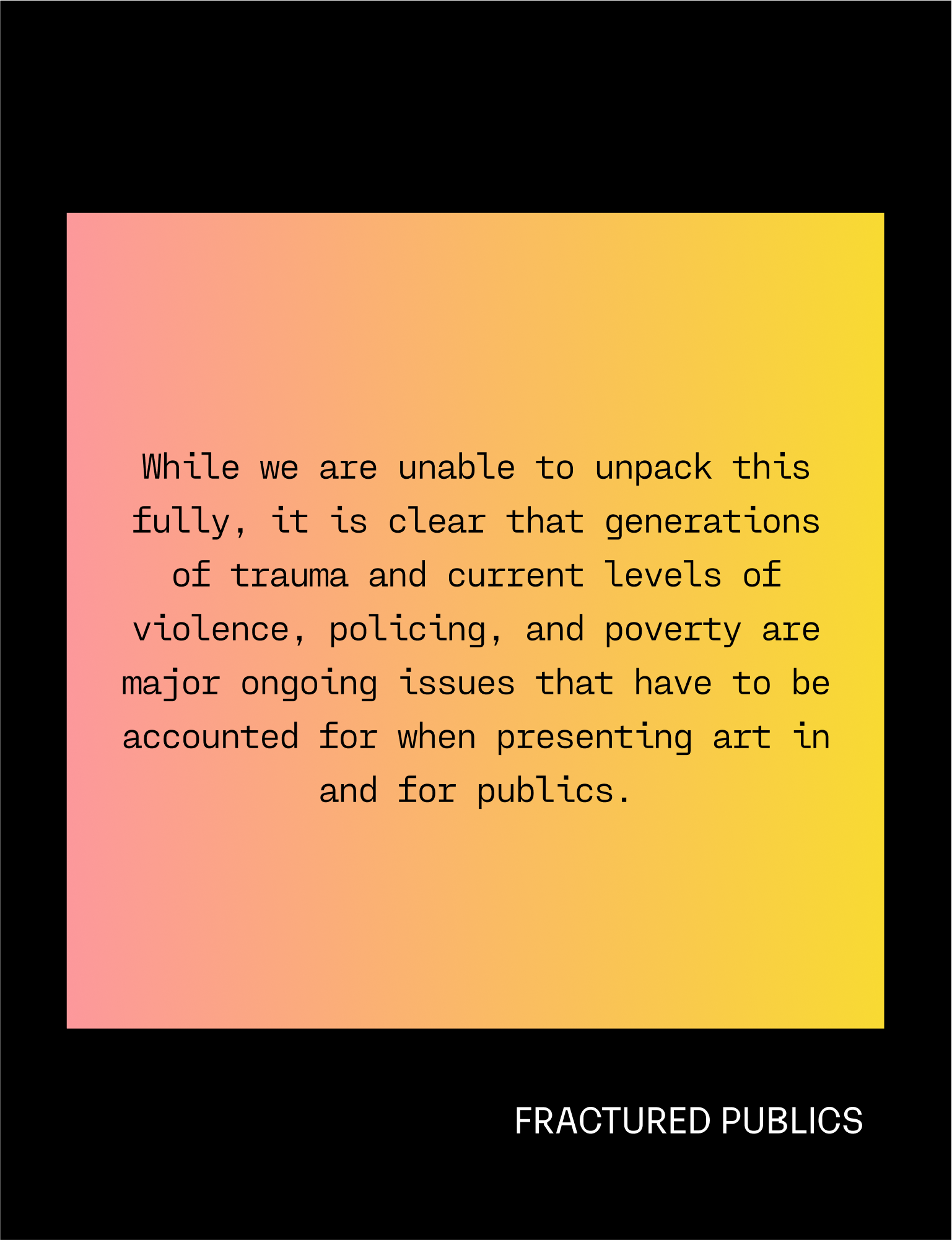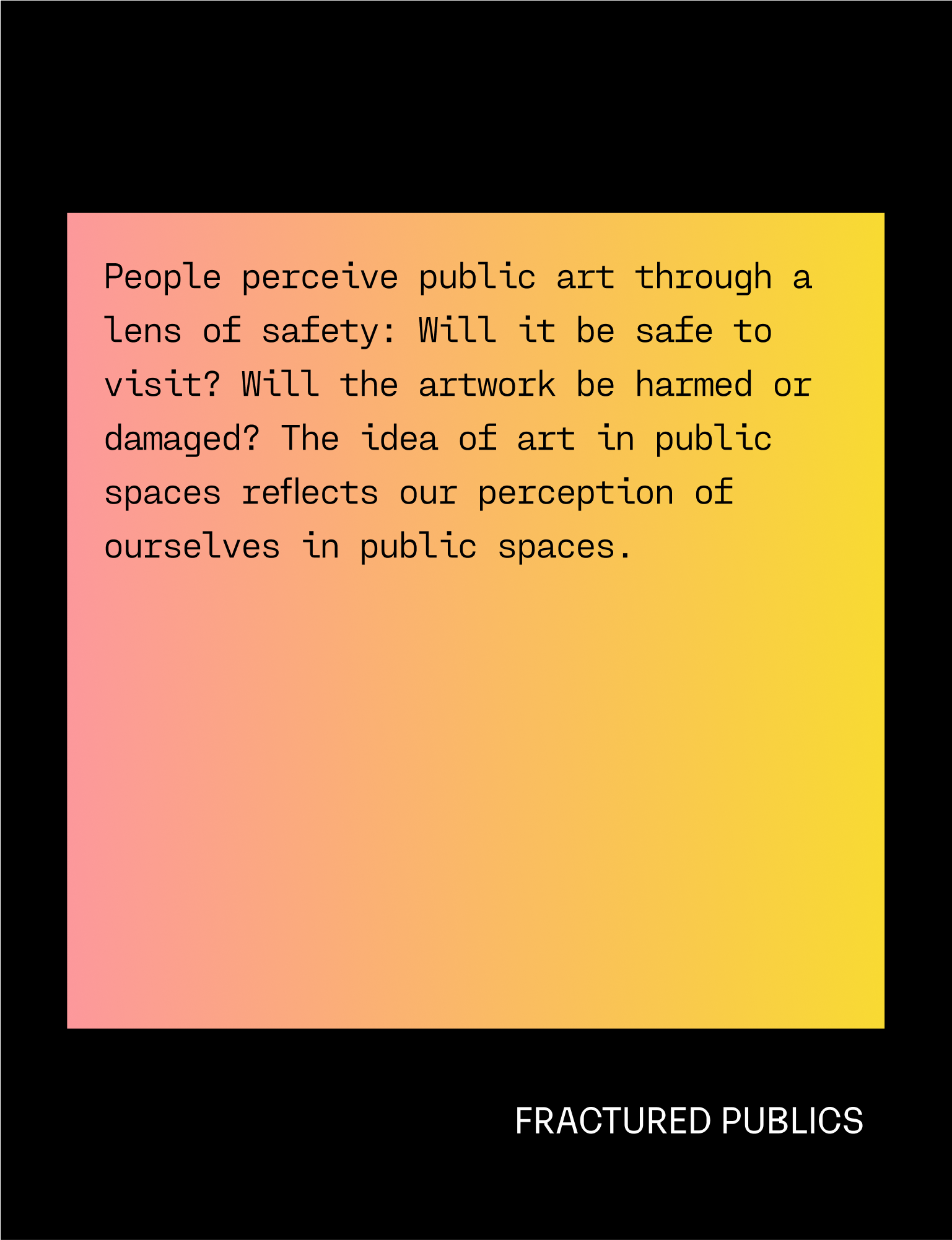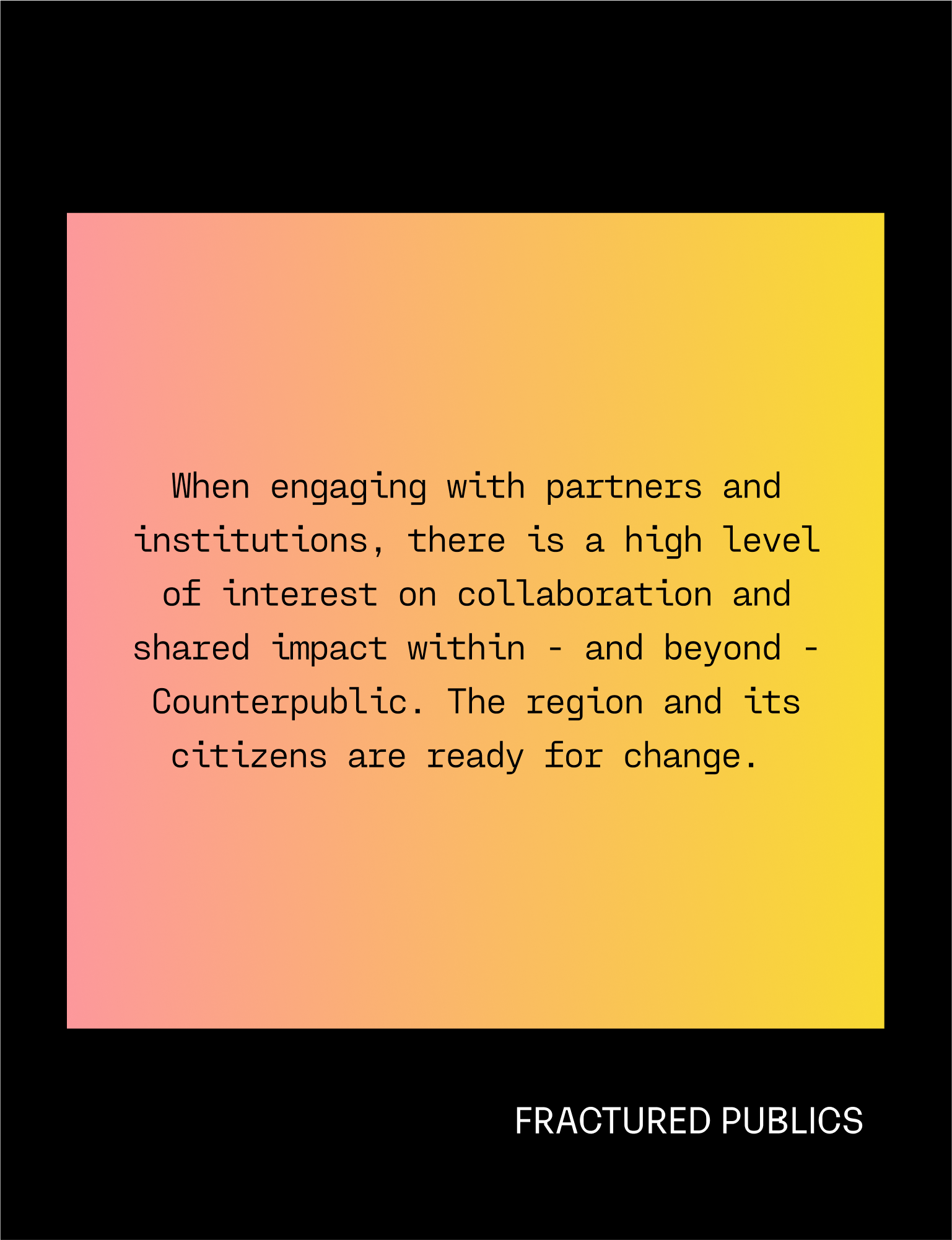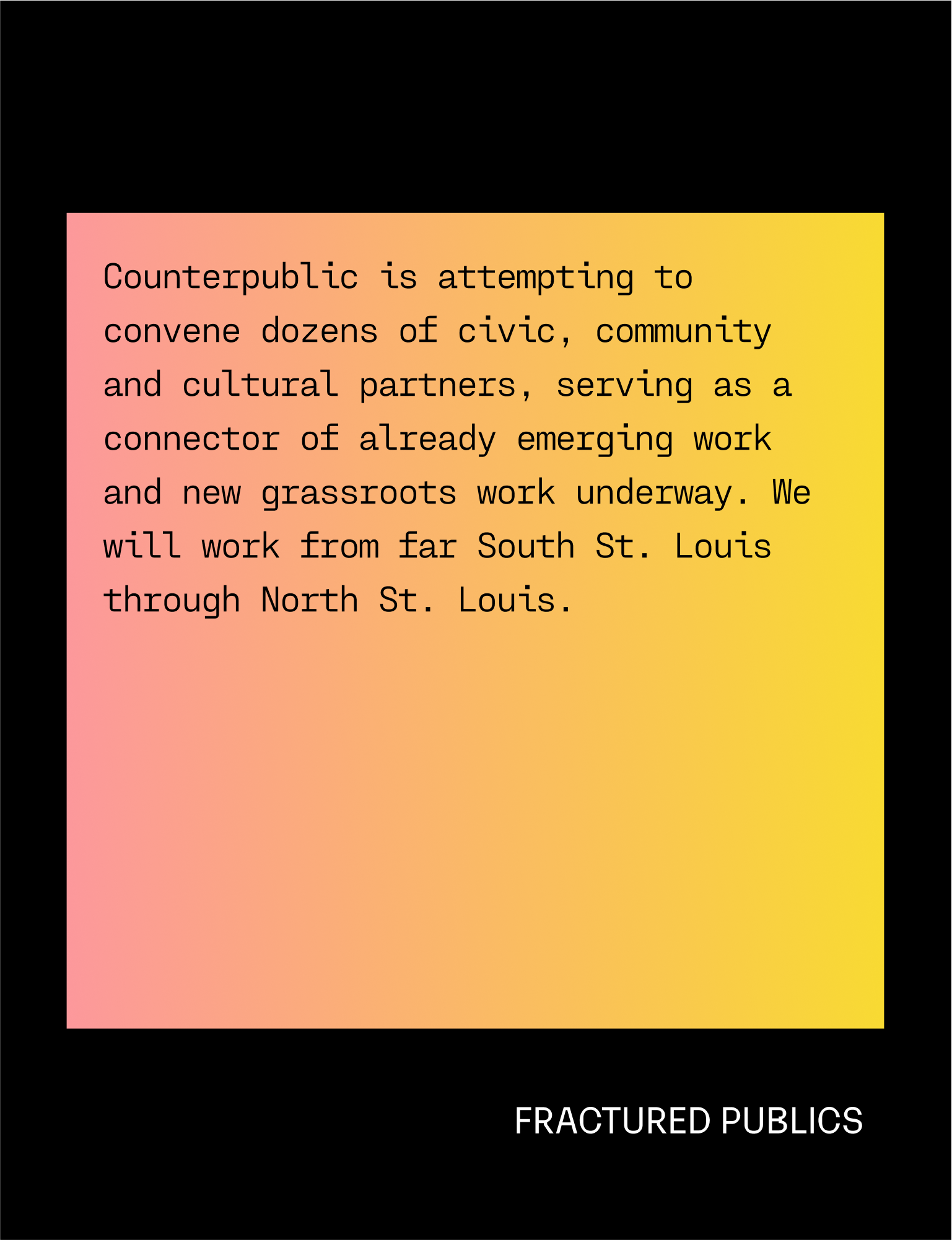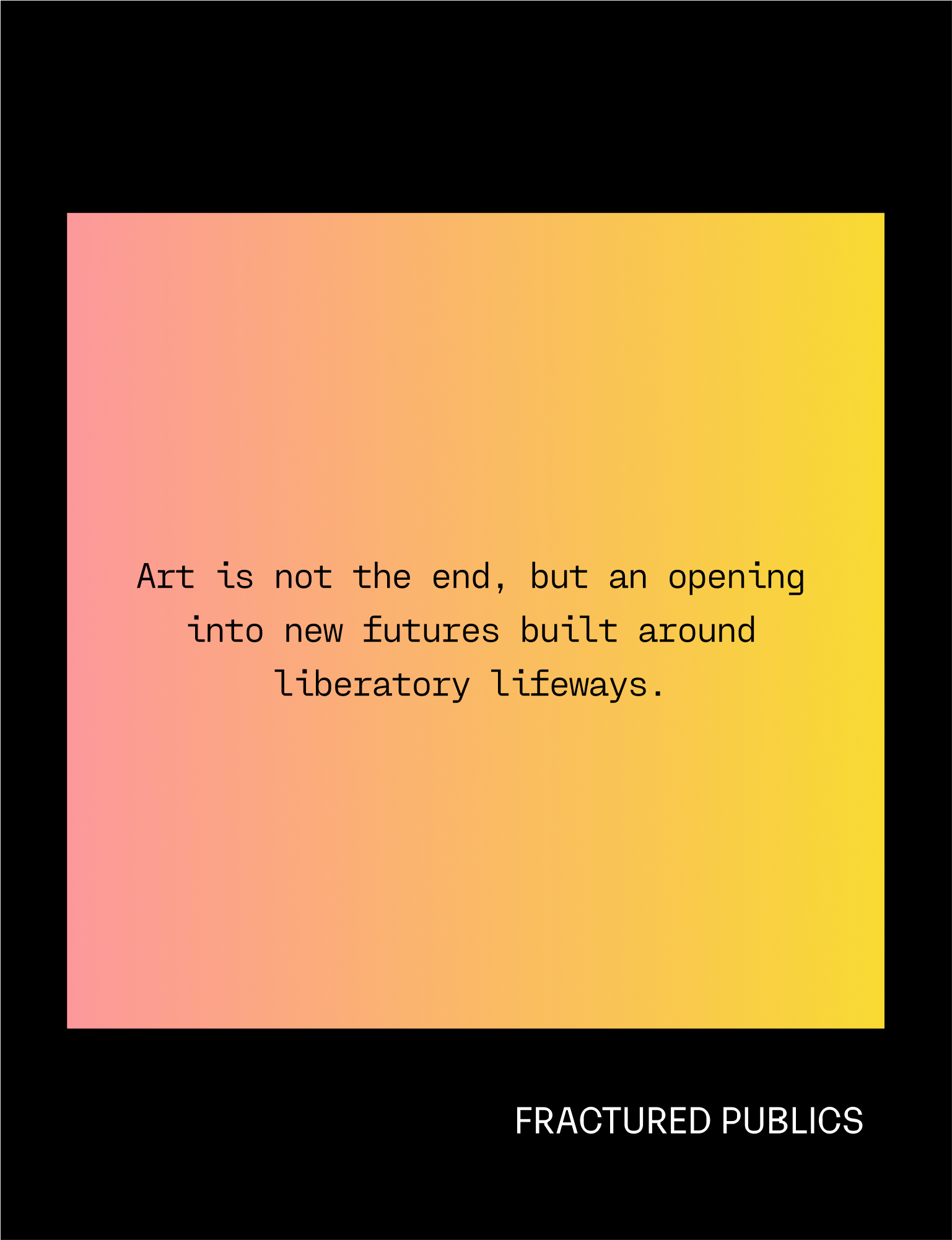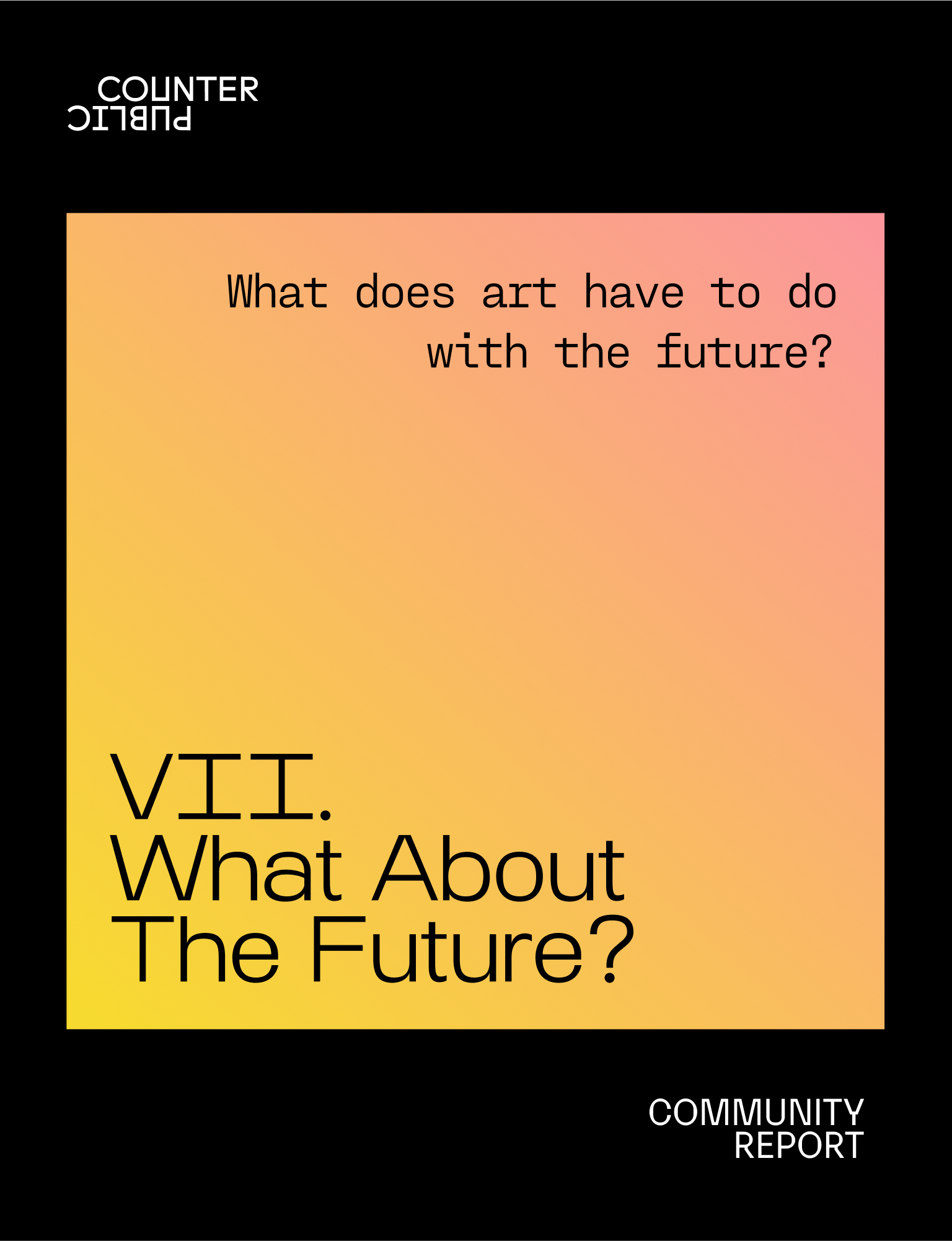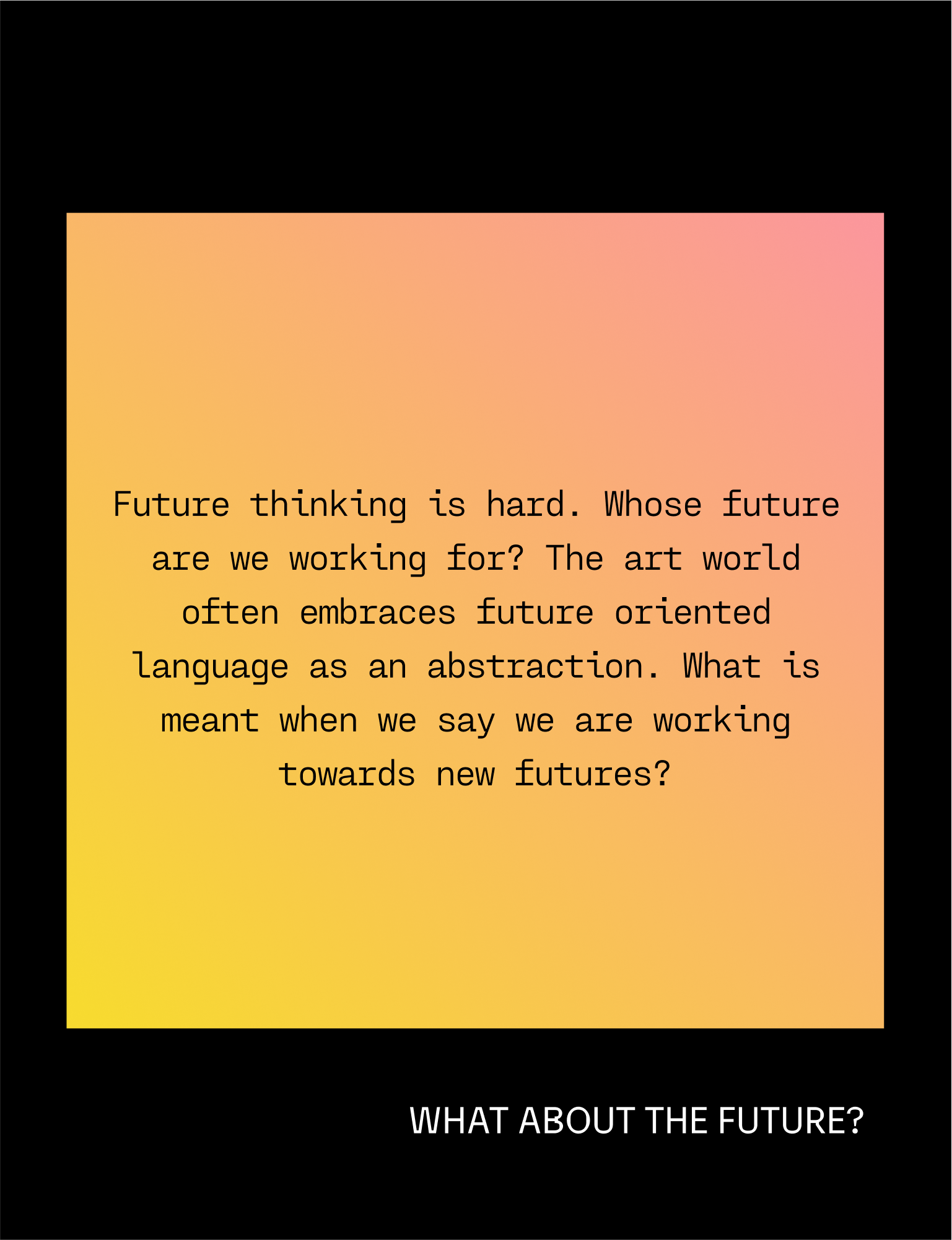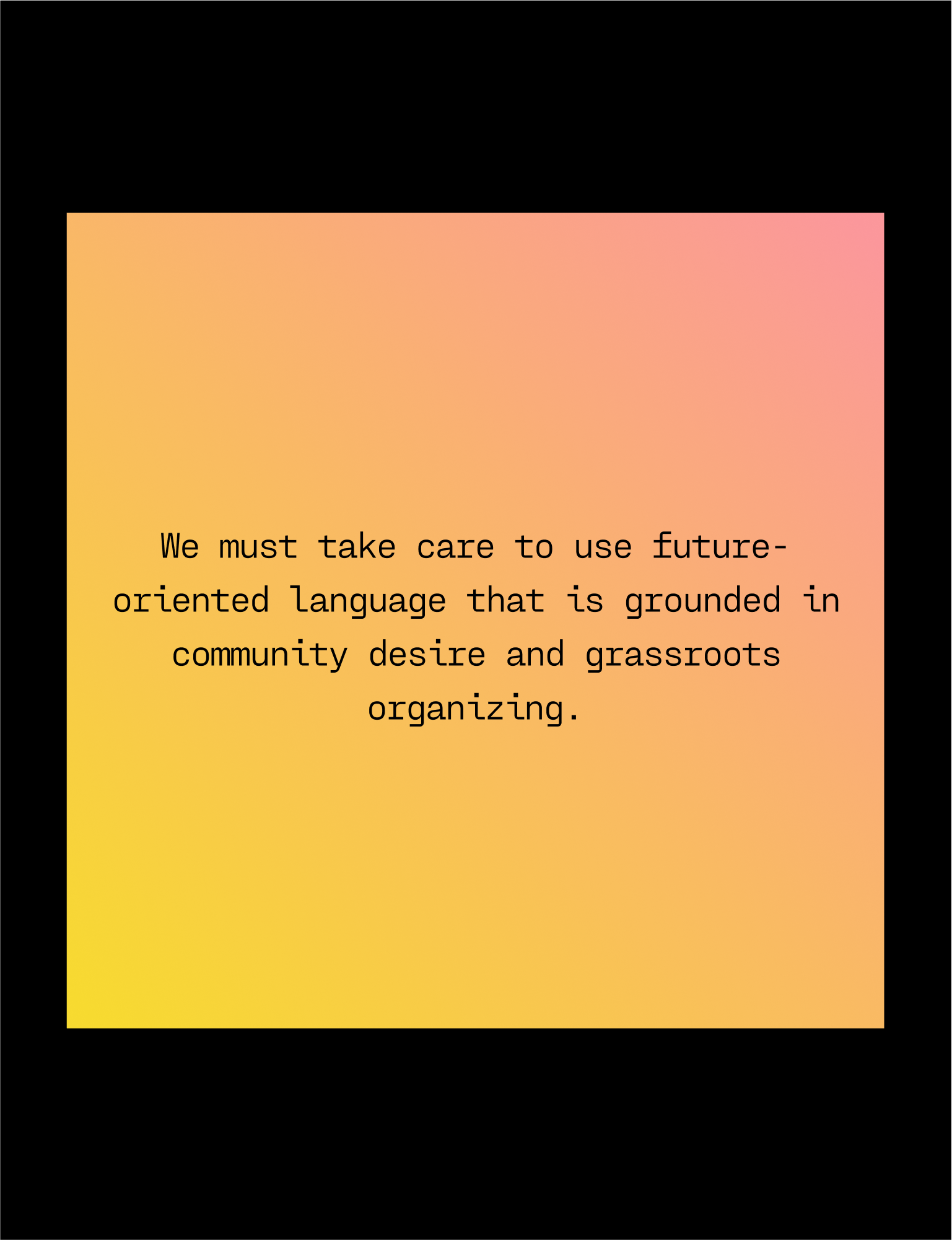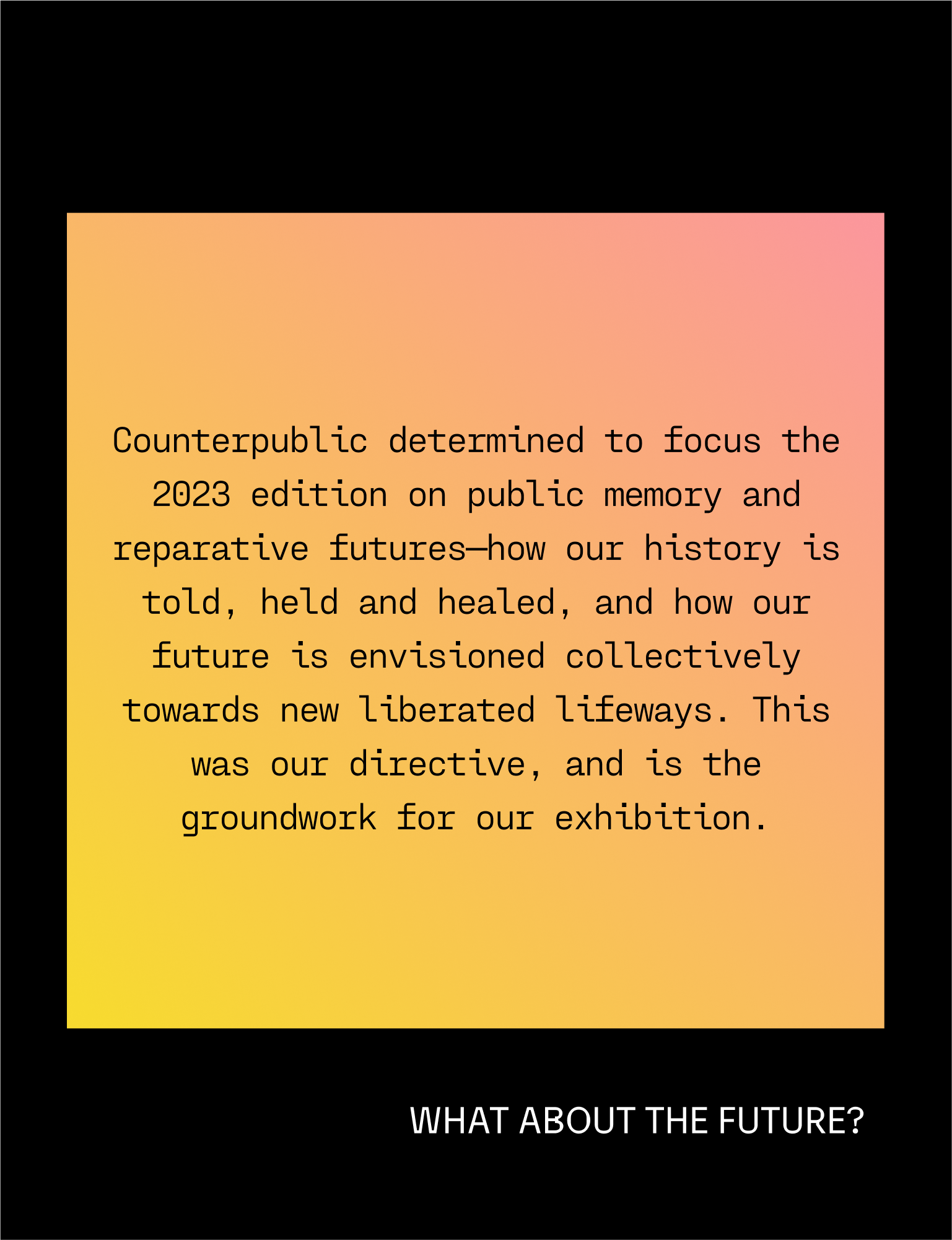Community Report
Across a year-long process of community engagement led by Cheeraz Gormon and James McAnally, Counterpublic created a brief community report cataloging our neighbors’ responses to pressing issues facing them and ways Counterpublic could respond through its 2023 exhibition.
Following this feedback, Counterpublic determined to focus the 2023 edition on public memory and reparative futures—how our history is told, held and healed and how our future is envisioned collectively towards repair.
This report will be mobilized by artists, curators and community organizers throughout the exhibition cycle to ensure all projects respond to community needs and conditions. This is not an exhaustive document, nor is it meant as an objective report. Rather, it is a living conversation that will continue to evolve throughout the 2023 exhibition.
Some of our findings include the following distilled points:
I. Memory + Commemoration
How is our history told, held and healed?
Public memory work, commemoration, and acknowledgement is very important for our community.
One of the most consistent things we heard is how so many histories in St. Louis have been ignored, erased and intentionally forgotten. From Mill Creek Valley to the Mississippian Mounds, entire histories have been actively disappeared.
An accumulation of erased narratives big and small make many people in Saint Louis feel as if the history they have experienced is denied by the city and those in power.
New monuments and public memory projects are strongly desired. This was the number one request of Counterpublic from many in the community.
Equally important to inclusive new monuments and public commemorations is an interest in undoing past harms and engaging in repair work. Without this process of repair, engaging the future starts from a deficit of trust and imagination for how it may be different.
We are not in a silo. Counterpublic is working in coalition with numerous grassroots initiatives and cultural partners on this work. From partners like The Griot and Monument Lab to MO History Museum and the Reparative Justice Coalition, civic memory is being renewed in public space.
The questions that St. Louis faces are the questions of the moment: of public memory, of repair, of how you move forward with the weight of history.
II. Indigeneous Histories + Futures
How do we acknowledge and empower Indigenous communities?
The St. Louis region is central to Indigenous history as the home of the largest pre-Columbian city in the present day United States. Now it must be central to repair and to repatriation.
As the Gateway to the West, St. Louis was a primary site of Native removal. From Thomas Hart Benton’s calls of manifest destiny to being the armory for Western expansion, the systematic removal and erasure of Native peoples was brutal and near-total. This legacy is ever-present in the region from mound removal to lack of acknowledgement of the numerous tribes with direct lineage to this area.
There are no State or Federally recognized Tribes in Missouri, and no central advocate to garner resources, organize the community, and give visibility to Indigenous community members. This leads to pressure on a small number of organizations and organizers, including the Buder Center at the Brown School of Social Work and the Native Women’s Care Circle, to carry responsibilities beyond their capacity.
It was illegal for decades for a Native person to own property in Missouri, so they either had to leave or deny their identity and cultural connection. Many of those who remained in the region struggle with connection to ancestors and especially with identification with the city and its systems.
Counterpublic 2023 aims to center Indigenous histories–and futures—through storytelling, public memory and pedagogy, and through the documentation and support of repatriation and “land back” efforts within the region.
Working at Sugarloaf Mound with Osage Nation - the last intact Mississippian mound in the City of St. Louis - we will contextualize these histories and help seed new sovereignties and new systems of support as a core part of our program.
III. Art is Only the Start
How can we go beyond art to connect with the needs of the community?
Community Engagement Must be Holistic
To talk about art’s role in one’s neighborhood, one must have basic needs met. Engaging residents in vulnerable populations requires additional resources: eviction and utilities assistance; mental health support; transportation; and so on. Art doesn’t enter in a vacuum.
Given the level of need in each community, community engagement must be collaborative and done in partnership with existing institutions, community organizers, and others able to offer resources beyond one organization and beyond the arts.
Part of our community engagement process has been “modeling up”: pressing partners to do more, sharing our learning and insights with others, and encouraging a more active approach to community engagement across all spectrums.
Art offers an opening towards generational change. We aim to leverage the resources and opportunities within the art world towards lasting impact held in community. Over 50% of our budget will remain in community organizations.
The work of the future is already here. It is in artist’s studios, but also in the grassroots work underway in our neighborhoods, in the mutual aid work of the last few years, in the community organizers and organizations. We aim to accelerate that change, working in and beyond art towards generational change.
IV. Systems of Power: Access + Transparency
How can an exhibition engage systems of power?
We started our engagement process by looking at “power maps” and assessing where power was held in our community, and where it is withheld.
As observed in many conversations, there is a lack of trust in any "top-down" process. How development happens. How decisions get made. People used the phrase “The City” to stand in for many forms of power: civic, corporate, political, financial. For many, the city is synonymous with whiteness.
In conversations with many, this trust was tentatively being rebuilt through political shifts: the election of Tishaura Jones, Rasheen Aldridge and Cori Bush were repeatedly referenced as some of the most hopeful moments in the region’s recent history. This is a moment to build connection across silos.
Our success as a civic exhibition is tied to the faultlines and futures of those around us.
Counterpublic will work in deep partnership with existing community anchors, ensuring our work has lasting impact. Over 50% of our budget will go directly to existing small-scale, community oriented partners.
V. Gentrification and Neighborhood Change
How can an exhibition support community-led land practices, preservation and place-keeping?
Gentrification is a major concern along the Jefferson Ave footprint. With rising housing prices in South St. Louis and major developments in and around the NGA, questions of development and gentrification are among the first things most residents respond to.
Counterpublic 2023 touches on 13 different neighborhoods along Jefferson Ave. The issues of the city are in the daily textures of life. Housing is key to the city’s future.
Our investments are in and for neighborhoods and neighborhood anchors, not speculation. Art’s relationship with development and gentrification must be acknowledged and resisted - particularly in a biennial or triennial that can serve to accelerate these inequities.
Artist projects for Counterpublic 2023 will partner with community-led land trusts and will commission projects focused on land transfers and housing justice, land back actions and place-keeping initiatives.
VI. Fractured Publics
How can an exhibition be a convener of the community?
St. Louis has long been a poster example of fragmentation. From civic structures to county boundaries, the region remains in pieces.
Again and again, we have encountered groups large and small who it seems should be working together or perhaps were working together that have experienced a rift and are unable to initiate collaboration. What is happening on a civic level is happening in many other places in our communities.
While we are unable to unpack this fully here, it is clear that generations of trauma and current levels of violence, policing, and poverty are major ongoing issues that have to be accounted for when presenting art in and for publics.
People perceive public art through a lens of safety: Will it be safe to visit? Will the artwork be harmed or damaged? The idea of art in public spaces reflects our perception of ourselves in public spaces. Other approaches are required to undo approaching public art through the language of policing.
When engaging with partners and institutions, there is a high level of interest on collaboration and shared impact within - and beyond - Counterpublic. The region and its citizens are ready for change.
Counterpublic is attempting to convene dozens of civic, community and cultural partners, serving as a connector of already emerging work and new grassroots work underway. We will work from far South St. Louis through North St. Louis acting as a connector across sectors.
Art is not the end, but an opening into new futures built around liberatory lifeways.
VII. What About the Future?
What does art have to do with the future?
Future thinking is hard. Whose future are we working for? The art world often embraces future oriented language as an abstraction. What is meant when we say we are working towards new futures?
Future = Harm. Future-oriented language is often associated with harm, as it is what is used by civic leaders, developers, politicians, and others to sell something that is unwanted. Mill Creek Valley clearance was about the future, as was Pruitt-Igoe, and other examples of land banking and demolition.
We must take care to use future-oriented language that is grounded in community desire and grassroots organizing.
Our community engagement made it clear that the future starts with commemoration and repair. This is the ground where we must start.
Counterpublic determined to focus the 2023 edition on public memory and reparative futures—how our history is told, held and healed, and how our future is envisioned collectively towards new liberated lifeways. This was our directive, and is the groundwork for our exhibition.

